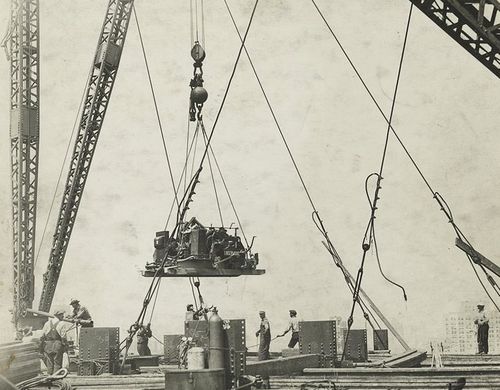JF Ptak Science Books Post 1878
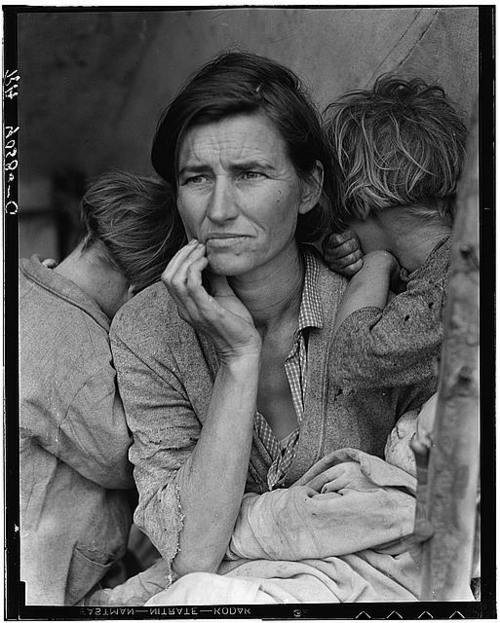
Dorothea Lange, a standard portrait photographer-turned-superb-documentarian, had a six-year-run of photographic success and inspiration and energy as few people have ever experienced in the history of photography From her 1936 Migrant Mother, which is perhaps the great photograph of the American Great Depression (which I wrote about in The Best Dollar the U.S. Government Ever Spent) to the wicked sharpness of her documenting the terrible business of relocating Japanese American citizens to concentration camps in 1942. Lange traveled the country recording the state of Americans in what may have been one of the great journeys of th 1930's.
The period in which this was all happening was one of the most chaotic in modern history--at least in the West. The Depression was full-bore-on, of course; as Germany strained its way into confrontation with the rest of the world, taking its calculated and inexorable steps towards world hemispheric chaos. The other images of these six years are almost a dada-kaleidoscopic assembly of the believable and the not believable: Sudetendland, Kristallnacht, Neville Chamerbalin, Austria, Poland, Nanking, Canton, War of the Worlds, Munich Agreement, WWII in Europe, Spanish Revolution, lynching, Jewish explusion, concentration camps, Pearl Harbor. In the United States, there was a certain right-wing element that ran deep into the national consciousness, the worst embodied in Father Coughlin's filthy radio diatribes on keeping America out of war wrapped in Jew-hating monologues, the ridiculous semi-levitating philosopher-fake and home-town-boy-gone-bad Charles Pelley and his Silver Shirts being part of his support; Henry Ford and his assault on Judaism and insistence on The Protocols of the Elders of Zion, Charles Lindbergh and America First, and so on., and for a divisive time until the crystalizing of Pearl Harbor.
The literature of this time, of this 1936-1942 period, expressing the soul of the country seems pretty full, with these few works standing as good examples of the work of the period: John Steinbeck's beginning in "the Harvest Gypsies"/Their Blood is Strong, The Grapes of Wrath, Faulkner's Absolom! Absolom! (1936), Pare Lorentz The Plow that Broke the Plains, Carey McWIlliams Factories in the Field (1939), Taylor/Lange's An American Exodus (1939), For Whom the Bell Tolls (1940), the New Masses, Abel Meeropol’s anti-lynching poem "Strange Fruit", and so on, deeply on.
But perhaps in all of it, perhaps nothing else quite expresses the emotion of the period than Lange's Migrant Mother. It seems to have everything, in one photograph. In the vast result of Lange's work during this period it is interesting to have a look at her in Imperial Valley, California, in 1937--it seems less-often mentioned, though the work is very strong. So I decided to post a few of the images with a link to the rest of the collection (below).
Lange worte:
"I was forced to switch from Nipomo to the Imperial Valley because of the conditions there. They have always been notoriously bad as you know and what goes on in the Imperial is beyond belief. The Imperial Valley has a social structure all its own and partly because of its isolation in the state those in control get away with it. But this year's freeze practically wiped out the crop and what it didn't kill is delayed--in the meanwhile, because of the warm, no rain climate and possibilities for work the region is swamped with homeless moving families. The relief association offices are open day and night 24 hours. The people continue to pour in and there is no way to stop them and no work when they get there."

Former tenant farmers on relief. LC-USF34T01
Other samples below but a fuller listing of images is available here.
Imperial Valley, California, February and March 1937
Resettlement Administration
Notes:
1. Lange was still very new to the FSA project when she made this photograph in the spring of 1936. On the tail end of a month-long road trip she was nearing the end of her day when she spotted a hand-lettered sign "Pea-Pickers Camp" by the side of the road. Lange briefly considered stopping but went ahead, questioning her judgment continuously for the next 20 miles, when she finally turned around to find the turn-off for the camp. She drove down the dirt road and found a ramshackle assembly of tents, one of which contained "an exhausted mother sitting forlornly with her children". Lange spent only 10 minutes with the woman, making five exposures. She learned that "the crops had frozen, and the woman and children were living on vegetables scavenged from the fields, and the few birds that the children managed to catch. The mother could not leave; she had sold the tires from her car".
The images were made using a Graflex camera. The original negatives are 4x5" film.


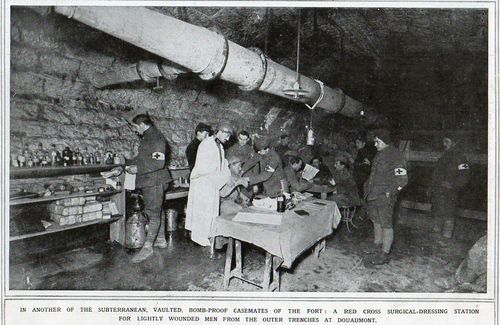

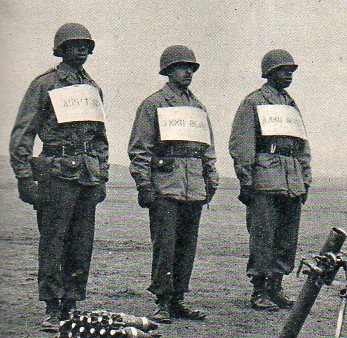
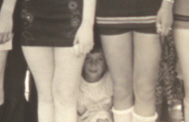

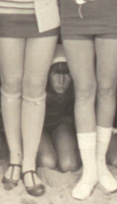
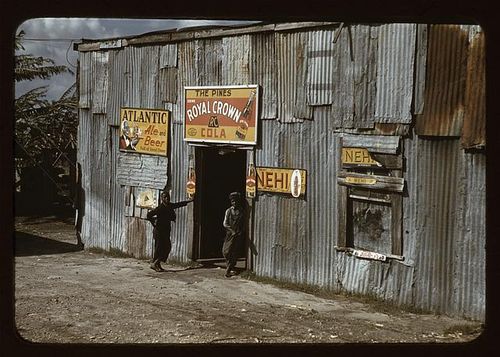
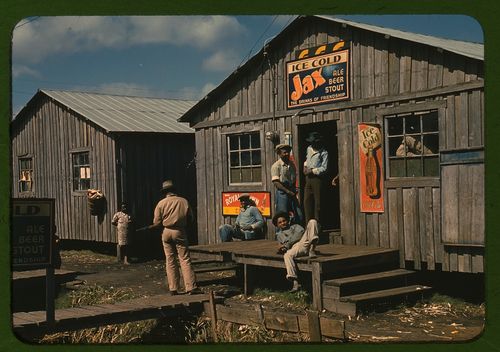


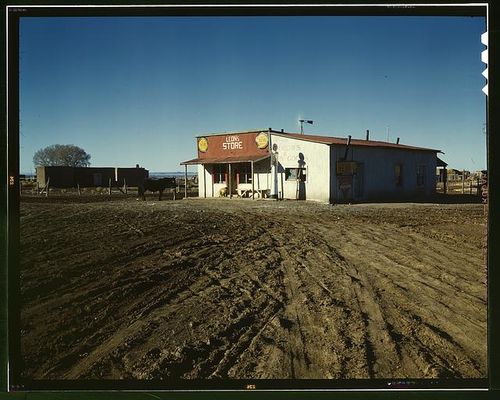
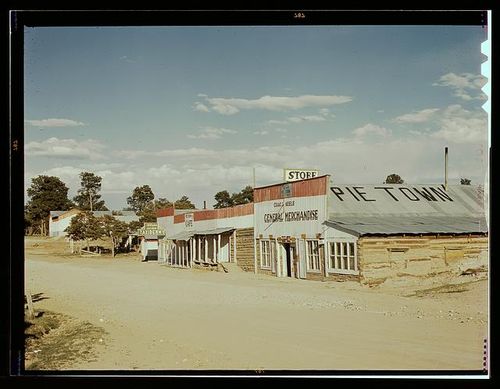
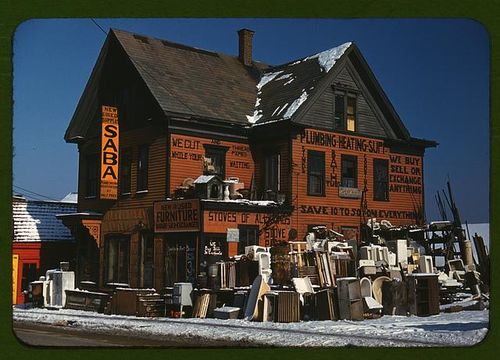
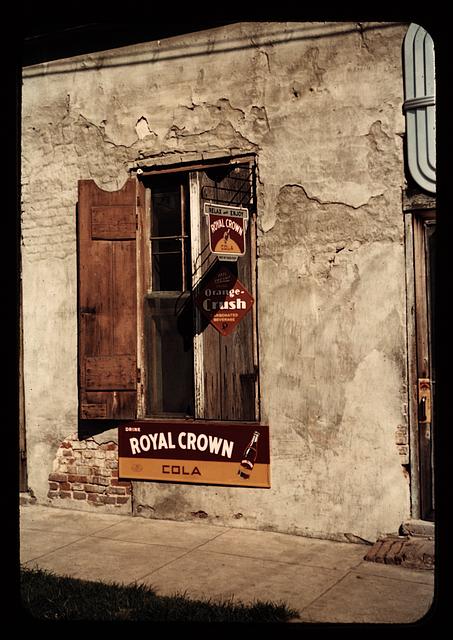
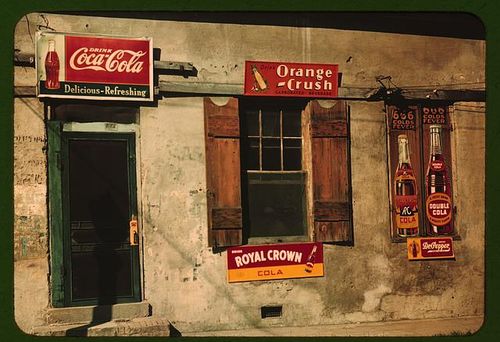






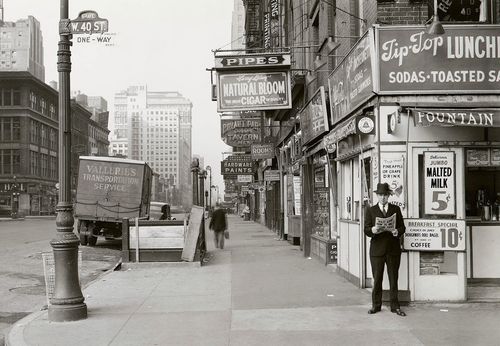
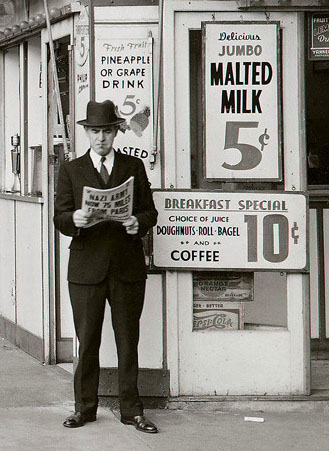
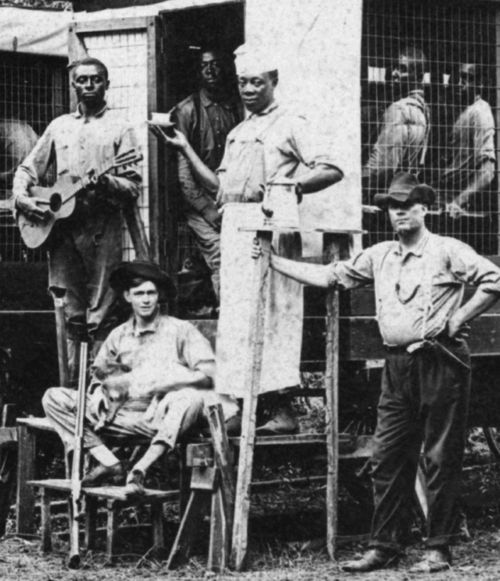

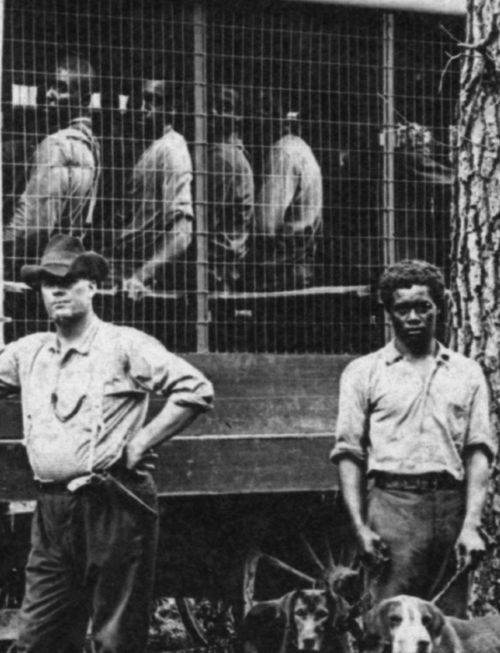
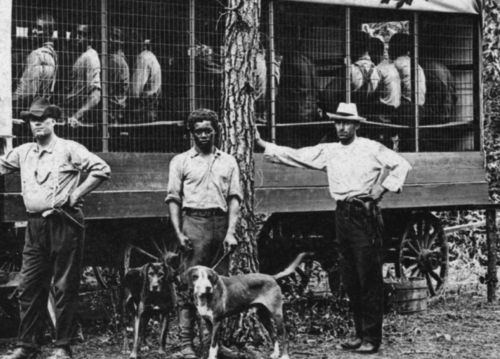

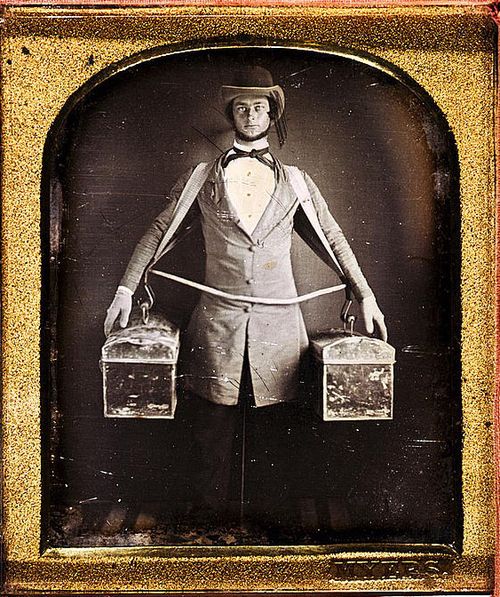
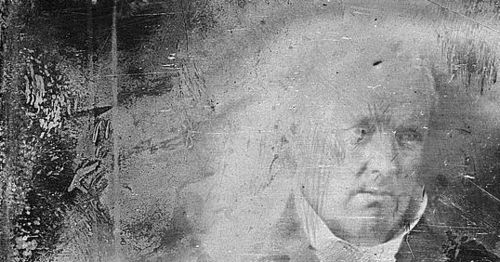
![[Unidentified U.S. Army officer, head-and-shoulders portrait, slightly to the right, in military uniform] digitized item thumbnail](http://lcweb2.loc.gov/service/pnp/cph/3c10000/3c10000/3c10000/3c10088_75x75px.jpg)
![[William Allen, half-length portrait, nearly facing front] digitized item thumbnail](http://lcweb2.loc.gov/service/pnp/cph/3c00000/3c09000/3c09800/3c09897_75x75px.jpg)
![[David Rice Atchison, half-length portrait, facing three-quarters to left] digitized item thumbnail](http://lcweb2.loc.gov/service/pnp/cph/3c00000/3c09000/3c09900/3c09952_75x75px.jpg)
![[Unidentified woman in theatrical costume] digitized item thumbnail](http://lcweb2.loc.gov/service/pnp/cph/3c10000/3c10000/3c10100/3c10175_75x75px.jpg)
![[George Edmund Badger, half-length portrait, facing three-quarters to left] digitized item thumbnail](http://lcweb2.loc.gov/service/pnp/cph/3c00000/3c09000/3c09900/3c09929_75x75px.jpg)
![[George Edmund Badger, half-length portrait, facing three-quarters to the left] digitized item thumbnail](http://lcweb2.loc.gov/service/pnp/cph/3c10000/3c10000/3c10000/3c10072_75x75px.jpg)
![[Roger S. Baldwin, three-quarter length portrait, facing slightly left] digitized item thumbnail](http://lcweb2.loc.gov/service/pnp/cph/3c00000/3c09000/3c09800/3c09834_75x75px.jpg)
![[James Bankhead, half-length portrait, facing front, in military uniform, with sword] digitized item thumbnail](http://lcweb2.loc.gov/service/pnp/cph/3c10000/3c10000/3c10000/3c10055_75x75px.jpg)
![[Bishop Frederic Baraga, three-quarter length portrait, facing three-quarters to right, seated, in clerical robes, holding his Dictionary of the Otchipwe Language] digitized item thumbnail](http://lcweb2.loc.gov/service/pnp/cph/3c00000/3c09000/3c09800/3c09833_75x75px.jpg)
![[Alexander Barrow, half-length portrait, facing three-quarters to the left] digitized item thumbnail](http://lcweb2.loc.gov/service/pnp/cph/3c10000/3c10000/3c10100/3c10116_75x75px.jpg)
![[John Bell, head-and-shoulders portrait, facing slightly left, eyes front] digitized item thumbnail](http://lcweb2.loc.gov/service/pnp/cph/3c10000/3c10000/3c10000/3c10028_75x75px.jpg)
![[August Belmont, half-length portrait, facing three-quarters to right, with side whiskers] digitized item thumbnail](http://lcweb2.loc.gov/service/pnp/cph/3c00000/3c09000/3c09800/3c09850_75x75px.jpg)
![[Sesto Benedetti, three-quarter length portrait, facing three-quarters to right, with beard, sitting in chair, wearing large ring and figured waistcoat] digitized item thumbnail](http://lcweb2.loc.gov/service/pnp/cph/3c00000/3c09000/3c09900/3c09991_75x75px.jpg)
![[Unidentified man, half-length portrait, facing three-quarters to right, with beard] digitized item thumbnail](http://lcweb2.loc.gov/service/pnp/cph/3c00000/3c09000/3c09900/3c09992_75x75px.jpg)
![[Thomas Hart Benton, head-and-shoulders portrait, facing three-quarters to the left] digitized item thumbnail](http://lcweb2.loc.gov/service/pnp/cph/3c00000/3c09000/3c09900/3c09983_75x75px.jpg)
![[Thomas Hart Benton, head-and-shoulders portrait, facing front] digitized item thumbnail](http://lcweb2.loc.gov/service/pnp/cph/3c10000/3c10000/3c10000/3c10024_75x75px.jpg)
![[Rufus Blakeman, half-length portrait, three-quarters to the right, facing front, hands folded in lap] digitized item thumbnail](http://lcweb2.loc.gov/service/pnp/cph/3c00000/3c09000/3c09800/3c09880_75x75px.jpg)
![[Unidentified woman] digitized item thumbnail](http://lcweb2.loc.gov/service/pnp/cph/3c10000/3c10000/3c10100/3c10169_75x75px.jpg)
![[Unidentified man, probably Thomas Wilson Dorr, head-and-shoulders portrait, facing front] digitized item thumbnail](http://lcweb2.loc.gov/service/pnp/cph/3c10000/3c10000/3c10100/3c10140_75x75px.jpg)
![[Solon Borland, half-length portrait, facing three-quarters left] digitized item thumbnail](http://lcweb2.loc.gov/service/pnp/cph/3c00000/3c09000/3c09900/3c09949_75x75px.jpg)
![[Emma Gillingham Bostwick, half-length portrait of a woman, three-quarters to left, facing three-quarters to right] digitized item thumbnail](http://lcweb2.loc.gov/service/pnp/cph/3c00000/3c09000/3c09900/3c09909_75x75px.jpg)
![[William C. Bouck, head-and-shoulders portrait, facing front] digitized item thumbnail](http://lcweb2.loc.gov/service/pnp/cph/3c10000/3c10000/3c10000/3c10013_75x75px.jpg)
![[Hugh Brady, head-and-shoulders portrait, facing three-quarters left, in military uniform] digitized item thumbnail](http://lcweb2.loc.gov/service/pnp/cph/3c10000/3c10000/3c10000/3c10036_75x75px.jpg)
![[Hugh Brady, half-length portrait, facing front, in civilian dress] digitized item thumbnail](http://lcweb2.loc.gov/service/pnp/cph/3c10000/3c10000/3c10100/3c10176_75x75px.jpg)
![[Unidentified man, half-length portrait, body in profile to left, facing front, with beard] digitized item thumbnail](http://lcweb2.loc.gov/service/pnp/cph/3c00000/3c09000/3c09800/3c09847_75x75px.jpg)
![[Brady's Daguerrean Gallery] digitized item thumbnail](http://lcweb2.loc.gov/service/pnp/cph/3c00000/3c09000/3c09800/3c09858_75x75px.jpg)
![[George Douglas Brewerton, half-length portrait, three-quarters to right, eyes facing front, with beard, in civilian dress] digitized item thumbnail](http://lcweb2.loc.gov/service/pnp/cph/3c00000/3c09000/3c09900/3c09947_75x75px.jpg)
![[James Brown, half-length portrait, three-quarters to the right, eyes front, one hand on hip, wearing plaid waistcoat] digitized item thumbnail](http://lcweb2.loc.gov/service/pnp/cph/3c10000/3c10000/3c10000/3c10032_75x75px.jpg)
![[William Cullen Bryant, head-and-shoulders portrait, facing slightly left] digitized item thumbnail](http://lcweb2.loc.gov/service/pnp/cph/3c10000/3c10000/3c10100/3c10144_75x75px.jpg)
![[James Buchanan, three-quarter length portrait, three-quarters to the right] digitized item thumbnail](http://lcweb2.loc.gov/service/pnp/cph/3c10000/3c10000/3c10000/3c10022_75x75px.jpg)
![[James Buchanan, head-and-shoulders portrait, facing front] digitized item thumbnail](http://lcweb2.loc.gov/service/pnp/cph/3c10000/3c10000/3c10100/3c10115_75x75px.jpg)
![[James Buchanan, half-length portrait, three-quarters to the left] digitized item thumbnail](http://lcweb2.loc.gov/service/pnp/cph/3c10000/3c10000/3c10100/3c10150_75x75px.jpg)
![[Unidentified man, half-length portrait, three-quarters to the right] digitized item thumbnail](http://lcweb2.loc.gov/service/pnp/cph/3c10000/3c10000/3c10100/3c10142_75x75px.jpg)
![[Unidentified man, head-and-shoulders portrait, facing front] digitized item thumbnail](http://lcweb2.loc.gov/service/pnp/cph/3c00000/3c09000/3c09800/3c09891_75x75px.jpg)
![[F.B. Carpenter, head-and-shoulders portrait, three-quarters to the right] digitized item thumbnail](http://lcweb2.loc.gov/service/pnp/cph/3c10000/3c10000/3c10100/3c10148_75x75px.jpg)
![[Unidentified woman, three-quarter length portrait facing slightly right] digitized item thumbnail](http://lcweb2.loc.gov/service/pnp/cph/3g00000/3g04000/3g04100/3g04151_75x75px.jpg)
![[Unidentified man, half-length portrait, three-quarters to the left, eyes facing front, with beard] digitized item thumbnail](http://lcweb2.loc.gov/service/pnp/cph/3c00000/3c09000/3c09900/3c09976_75x75px.jpg)
![[Philander Chase, head-and-shoulders portrait, slightly to the left with eyes facing front, wearing clerical cap] digitized item thumbnail](http://lcweb2.loc.gov/service/pnp/cph/3c00000/3c09000/3c09800/3c09898_75x75px.jpg)
![[Charles Christofle, half-length portrait, three-quarters to the right] digitized item thumbnail](http://lcweb2.loc.gov/service/pnp/cph/3c00000/3c09000/3c09900/3c09968_75x75px.jpg)
![[Charles Christofle, half-length portrait, three-quarters to the right] digitized item thumbnail](http://lcweb2.loc.gov/service/pnp/cph/3c10000/3c10000/3c10000/3c10061_75x75px.jpg)
![[Cassius Marcellus Clay, half-length portrait, three-quarters to the right] digitized item thumbnail](http://rs16.loc.gov/service/pnp/ds/01200/01227_75x75px.jpg)
![[C.C. Clay, half-length portrait, head slightly to the right] digitized item thumbnail](http://lcweb2.loc.gov/service/pnp/cph/3c10000/3c10000/3c10000/3c10033_75x75px.jpg)
![[Henry Clay, head-and-shoulders portrait, facing front] digitized item thumbnail](http://lcweb2.loc.gov/service/pnp/cph/3c00000/3c09000/3c09900/3c09953_75x75px.jpg)
![[Henry Clay, three-quarter length portrait, three-quarters to the left, facing front, seated, holding cane, tall hat on table with tablecloth] digitized item thumbnail](http://lcweb2.loc.gov/service/pnp/cph/3c10000/3c10000/3c10100/3c10181_75x75px.jpg)
![[John M. Clayton, half-length portrait, three-quarters to the left] digitized item thumbnail](http://lcweb2.loc.gov/service/pnp/cph/3c00000/3c09000/3c09800/3c09843_75x75px.jpg)
![[Jeremiah Clemens, half-length portrait, facing front] digitized item thumbnail](http://lcweb2.loc.gov/service/pnp/cph/3c00000/3c09000/3c09900/3c09966_75x75px.jpg)
![[Howell Cobb, half-length portrait, facing front] digitized item thumbnail](http://lcweb2.loc.gov/service/pnp/cph/3c10000/3c10000/3c10000/3c10081_75x75px.jpg)
![[Howell Cobb, half-length portrait, three-quarters to the right] digitized item thumbnail](http://lcweb2.loc.gov/service/pnp/cph/3c10000/3c10000/3c10100/3c10133_75x75px.jpg)
![[Thomas Cole, head-and-shoulders portrait, facing slightly left] digitized item thumbnail](http://lcweb2.loc.gov/service/pnp/cph/3g00000/3g08000/3g08900/3g08981_75x75px.jpg)
![[Jacob Collamer, half-length portrait, three-quarters to left] digitized item thumbnail](http://lcweb2.loc.gov/service/pnp/cph/3c00000/3c09000/3c09800/3c09832_75x75px.jpg)
![[Thomas Corwin, half-length portrait, three-quarters to the left] digitized item thumbnail](http://lcweb2.loc.gov/service/pnp/cph/3c10000/3c10000/3c10000/3c10008_75x75px.jpg)
![[Thomas Corwin, full-length portrait, three-quarters to the left, standing by table with tablecloth, backdrop or reflector screen prominent on left] digitized item thumbnail](http://lcweb2.loc.gov/service/pnp/cph/3c10000/3c10000/3c10000/3c10058_75x75px.jpg)
![[William Cranch, half-length portrait, three-quarters to left] digitized item thumbnail](http://lcweb2.loc.gov/service/pnp/cph/3c00000/3c09000/3c09800/3c09848_75x75px.jpg)
![[Ichabod B. Crane, three-quarter length portrait, facing slightly right] digitized item thumbnail](http://lcweb2.loc.gov/service/pnp/cph/3c10000/3c10000/3c10000/3c10023_75x75px.jpg)
![[George Washington Crawford, half-length portrait, three-quarters to the left] digitized item thumbnail](http://lcweb2.loc.gov/service/pnp/cph/3c10000/3c10000/3c10100/3c10180_75x75px.jpg)
![[Unidentified man, head-and-shoulders portrait, facing front] digitized item thumbnail](http://lcweb2.loc.gov/service/pnp/cph/3c00000/3c09000/3c09800/3c09838_75x75px.jpg)
![[John J. Crittendon, head-and-shoulders portrait, facing front] digitized item thumbnail](http://lcweb2.loc.gov/service/pnp/cph/3c10000/3c10000/3c10000/3c10095_75x75px.jpg)
![[Unidentified man, head-and-shoulders portrait, facing right] digitized item thumbnail](http://lcweb2.loc.gov/service/pnp/cph/3c10000/3c10000/3c10100/3c10157_75x75px.jpg)
![[Crucifix] digitized item thumbnail](http://lcweb2.loc.gov/service/pnp/cph/3c10000/3c10000/3c10000/3c10043_75x75px.jpg)
![[George Washington Parke Custis, half-length portrait, three-quarters to the left, wearing white waistcoat] digitized item thumbnail](http://lcweb2.loc.gov/service/pnp/cph/3c10000/3c10000/3c10000/3c10010_75x75px.jpg)
![[F.B. Cutting, three-quarter length portrait, three-quarters to the left, seated in chair] digitized item thumbnail](http://lcweb2.loc.gov/service/pnp/cph/3c10000/3c10000/3c10100/3c10161_75x75px.jpg)
![[John Davis, head-and-shoulders portrait, facing slightly left] digitized item thumbnail](http://lcweb2.loc.gov/service/pnp/cph/3c10000/3c10000/3c10100/3c10173_75x75px.jpg)
![[William C. Dawson, head-and-shoulders portrait, three-quarters to right] digitized item thumbnail](http://lcweb2.loc.gov/service/pnp/cph/3c00000/3c09000/3c09800/3c09876_75x75px.jpg)
![[William L. Dayton, half-length portrait, three-quarters to the left] digitized item thumbnail](http://lcweb2.loc.gov/service/pnp/cph/3c00000/3c09000/3c09900/3c09930_75x75px.jpg)
![[Unidentified man, about 70 years of age, half-length portrait, three-quarters to the right, facing front, wearing figured waistcoat] digitized item thumbnail](http://lcweb2.loc.gov/service/pnp/cph/3c10000/3c10000/3c10000/3c10025_75x75px.jpg)
![[Daniel Dickinson, head-and-shoulders portrait, slightly to the left, facing front] digitized item thumbnail](http://lcweb2.loc.gov/service/pnp/cph/3c00000/3c09000/3c09800/3c09856_75x75px.jpg)
![[John A. Dix, half-length portrait, three-quarters to the left, in civilian dress, with long hair] digitized item thumbnail](http://lcweb2.loc.gov/service/pnp/cph/3c00000/3c09000/3c09900/3c09924_75x75px.jpg)
![[Alexander William Doniphan, head-and-shoulders portrait, facing front] digitized item thumbnail](http://lcweb2.loc.gov/service/pnp/cph/3c00000/3c09000/3c09900/3c09945_75x75px.jpg)
![[Stephen Arnold Douglas, head-and-shoulders portrait, slightly to left] digitized item thumbnail](http://lcweb2.loc.gov/service/pnp/cph/3c10000/3c10000/3c10100/3c10141_75x75px.jpg)
![[Andrew Jackson Downing, image totally obscured] digitized item thumbnail](http://lcweb2.loc.gov/service/pnp/cph/3c10000/3c10000/3c10100/3c10172_75x75px.jpg)
![[Solomon Weathersbee Downs, half-length portrait, three-quarters to the left] digitized item thumbnail](http://lcweb2.loc.gov/service/pnp/cph/3c10000/3c10000/3c10000/3c10063_75x75px.jpg)
![[Peter Paul Duggan, half-length portrait, three-quarters to right, head in profile] digitized item thumbnail](http://lcweb2.loc.gov/service/pnp/cph/3c00000/3c09000/3c09900/3c09917_75x75px.jpg)
![[James Duncan, three-quarters to the right, in military uniform] digitized item thumbnail](http://lcweb2.loc.gov/service/pnp/cph/3c10000/3c10000/3c10100/3c10103_75x75px.jpg)
![[Unidentified man, half-length portrait, three-quarters to right, eyes front, with monocle suspended around neck] digitized item thumbnail](http://lcweb2.loc.gov/service/pnp/cph/3c00000/3c09000/3c09900/3c09948_75x75px.jpg)
![[Asher Brown Durand, half-length portrait, three-quarters to the right, head three-quarters to the left, with both hands resting on cane, at right] digitized item thumbnail](http://lcweb2.loc.gov/service/pnp/cph/3c00000/3c09000/3c09900/3c09970_75x75px.jpg)
![[Asher Brown Durand, head-and-shoulders portrait, three-quarters to the right, head three-quarters to the left] digitized item thumbnail](http://lcweb2.loc.gov/service/pnp/cph/3c10000/3c10000/3c10100/3c10156_75x75px.jpg)
![[Pliny Earle, three-quarters to left] digitized item thumbnail](http://lcweb2.loc.gov/service/pnp/cph/3c00000/3c09000/3c09900/3c09935_75x75px.jpg)
![[Editorial staff of the New York Tribune] digitized item thumbnail](http://lcweb2.loc.gov/service/pnp/cph/3c10000/3c10000/3c10100/3c10182_75x75px.jpg)
![[Judge Edwards, head-and-shoulders portrait, three-quarters to the left] digitized item thumbnail](http://lcweb2.loc.gov/service/pnp/cph/3c10000/3c10000/3c10000/3c10049_75x75px.jpg)
![[James Bruce Elgin, 8th Earl of Elgin, head-and-shoulders portrait, three-quarters to right] digitized item thumbnail](http://lcweb2.loc.gov/service/pnp/cph/3c10000/3c10000/3c10100/3c10153_75x75px.jpg)
![[Michael Faraday, half-length portrait, three-quarters to the right, seated in chair, hand resting on table] digitized item thumbnail](http://lcweb2.loc.gov/service/pnp/cph/3g00000/3g06000/3g06700/3g06710_75x75px.jpg)
![[Unidentified man, head-and-shoulders portrait, three-quarters to the right, the head in profile, with side whiskers] digitized item thumbnail](http://lcweb2.loc.gov/service/pnp/cph/3c00000/3c09000/3c09900/3c09977_75x75px.jpg)
![[Unidentified man, head-and-shoulders portrait, slightly to the right, head slightly to the left, with spectacles and full beard] digitized item thumbnail](http://lcweb2.loc.gov/service/pnp/cph/3c10000/3c10000/3c10000/3c10001_75x75px.jpg)
![[David Dudley Field, half-length portrait, three-quarters to right] digitized item thumbnail](http://lcweb2.loc.gov/service/pnp/cph/3c00000/3c09000/3c09900/3c09910_75x75px.jpg)
![[Benjamin Fitzpatrick, half-length portrait, slightly to left] digitized item thumbnail](http://lcweb2.loc.gov/service/pnp/cph/3c10000/3c10000/3c10000/3c10038_75x75px.jpg)
![[Azariah C. Flagg, half-length portrait, three-quarters to the left] digitized item thumbnail](http://lcweb2.loc.gov/service/pnp/cph/3c10000/3c10000/3c10000/3c10026_75x75px.jpg)
![[Henry S. Foote, half-length portrait, slightly to the right] digitized item thumbnail](http://lcweb2.loc.gov/service/pnp/cph/3c10000/3c10000/3c10100/3c10163_75x75px.jpg)
![[Edwin Forrest, head-and-shoulders portrait, facing right] digitized item thumbnail](http://lcweb2.loc.gov/service/pnp/cph/3c10000/3c10000/3c10200/3c10205_75x75px.jpg)
![[Edwin Forrest, head-and-shoulders portrait, nearly in profile to the left] digitized item thumbnail](http://lcweb2.loc.gov/service/pnp/cph/3c00000/3c09000/3c09800/3c09868_75x75px.jpg)
![[Edwin Forrest, head-and-shoulders portrait, nearly in profile to the right, with side whiskers] digitized item thumbnail](http://lcweb2.loc.gov/service/pnp/cph/3c00000/3c09000/3c09800/3c09885_75x75px.jpg)
![[Junius Booth, half-length portrait, three-quarters to the left, in theatrical costume] digitized item thumbnail](http://lcweb2.loc.gov/service/pnp/cph/3g00000/3g06000/3g06700/3g06711_75x75px.jpg)
![[Unidentified man, half-length portrait, three-quarters to the right] digitized item thumbnail](http://lcweb2.loc.gov/service/pnp/cph/3c10000/3c10000/3c10100/3c10170_75x75px.jpg)
![[John Francis, half-length portrait, three-quarters to the right] digitized item thumbnail](http://lcweb2.loc.gov/service/pnp/cph/3c00000/3c09000/3c09900/3c09904_75x75px.jpg)
![[John Francis, half-length portrait, three-quarters to the right] digitized item thumbnail](http://lcweb2.loc.gov/service/pnp/cph/3c10000/3c10000/3c10000/3c10054_75x75px.jpg)
![[Benjamin B. French, half-length portrait, facing left] digitized item thumbnail](http://lcweb2.loc.gov/service/pnp/cph/3c10000/3c10000/3c10000/3c10030_75x75px.jpg)
![[Ezra Bartlett French, half-length portrait, facing front] digitized item thumbnail](http://lcweb2.loc.gov/service/pnp/cph/3c00000/3c09000/3c09900/3c09940_75x75px.jpg)
![[Albert Gallatin, head-and-shoulders portrait, facing front, with walking stick] digitized item thumbnail](http://lcweb2.loc.gov/service/pnp/cph/3c10000/3c10000/3c10000/3c10017_75x75px.jpg)
![[John Lane Gardner, head-and-shoulders portrait, facing right] digitized item thumbnail](http://lcweb2.loc.gov/service/pnp/cph/3c00000/3c09000/3c09800/3c09841_75x75px.jpg)
![[Giuseppe Garibaldi, head-and-shoulders portrait, slightly to the left, with full beard] digitized item thumbnail](http://lcweb2.loc.gov/service/pnp/cph/3c10000/3c10000/3c10100/3c10171_75x75px.jpg)
![[Colonel William Gates, head-and-shoulders portrait, three-quarters to the right, in military uniform] digitized item thumbnail](http://lcweb2.loc.gov/service/pnp/cph/3c10000/3c10000/3c10100/3c10102_75x75px.jpg)
![[Joshua R. Giddings, half-length poirtrait, facing slightly right] digitized item thumbnail](http://lcweb2.loc.gov/service/pnp/cph/3c10000/3c10000/3c10100/3c10107_75x75px.jpg)
![[Samuel G. Goodrich, head-and-shoulders portrait, three-quarters to the left, wearing spectacles] digitized item thumbnail](http://lcweb2.loc.gov/service/pnp/cph/3c00000/3c09000/3c09900/3c09978_75x75px.jpg)
![[Samuel G. Goodrich, head-and-shoulders portrait, three-quarters to the right] digitized item thumbnail](http://lcweb2.loc.gov/service/pnp/cph/3c10000/3c10000/3c10000/3c10016_75x75px.jpg)
![[Henry Peters Gray, half-length portrait, head three-quarters to left] digitized item thumbnail](http://lcweb2.loc.gov/service/pnp/cph/3g00000/3g04000/3g04100/3g04153_75x75px.jpg)
![[Horace Greeley, full-length portrait, three-quarters to the right, seated in chair, wearing tall hat, folded newspaper in lap, carpet on floor] digitized item thumbnail](http://lcweb2.loc.gov/service/pnp/cph/3g00000/3g03000/3g03800/3g03888_75x75px.jpg)
![[Mary Woodburn Greeley, half-length portrait of a woman, slightly to the right, facing front, wearing spectacles] digitized item thumbnail](http://lcweb2.loc.gov/service/pnp/cph/3c10000/3c10000/3c10000/3c10073_75x75px.jpg)
![[Unidentified woman, half-length portrait, three-quarters to the left, wearing white lace cap] digitized item thumbnail](http://lcweb2.loc.gov/service/pnp/cph/3c10000/3c10000/3c10100/3c10138_75x75px.jpg)
![[Henry Grinnell, head-and-shoulders portrait, profile to the left] digitized item thumbnail](http://lcweb2.loc.gov/service/pnp/cph/3c10000/3c10000/3c10000/3c10059_75x75px.jpg)
![[Henry Grinnell, head-and-shoulders portrait, three-quarters to the left] digitized item thumbnail](http://lcweb2.loc.gov/service/pnp/cph/3c10000/3c10000/3c10100/3c10168_75x75px.jpg)
![[Unidentified man, half-length portrait, three-quarters to the left] digitized item thumbnail](http://lcweb2.loc.gov/service/pnp/cph/3c00000/3c09000/3c09900/3c09971_75x75px.jpg)
![[William McKendree Gwin, half-length portrait, three-quarters to the right] digitized item thumbnail](http://lcweb2.loc.gov/service/pnp/cph/3c10000/3c10000/3c10000/3c10003_75x75px.jpg)
![[John P. Hale, head-and-shoulders portrait, facing front] digitized item thumbnail](http://lcweb2.loc.gov/service/pnp/cph/3c00000/3c09000/3c09900/3c09934_75x75px.jpg)
![[John P. Hale, head-and-shoulders portrait, face nearly in profile to the right] digitized item thumbnail](http://lcweb2.loc.gov/service/pnp/cph/3c10000/3c10000/3c10000/3c10048_75x75px.jpg)
![[A. Oakey Hall, half-length portrait, three-quarters to right, eyes front] digitized item thumbnail](http://lcweb2.loc.gov/service/pnp/cph/3c00000/3c09000/3c09900/3c09931_75x75px.jpg)
![[Unidentified man, three-quarter length portrait, three-quarters to the right, seated, with arm over back of chair, hand to cheek, with full beard, wearing jacket with elaborate trimming] digitized item thumbnail](http://lcweb2.loc.gov/service/pnp/cph/3c10000/3c10000/3c10000/3c10040_75x75px.jpg)
![[Nathan Kelsey Hall, half-length portrait, three-quarters to the left] digitized item thumbnail](http://lcweb2.loc.gov/service/pnp/cph/3c10000/3c10000/3c10100/3c10143_75x75px.jpg)
![[Gerard Hallock, half-length portrait, facing front, with chin whiskers] digitized item thumbnail](http://lcweb2.loc.gov/service/pnp/cph/3c00000/3c09000/3c09800/3c09865_75x75px.jpg)
![[Unidentified man, about 30 years of age, head-and-shoulders portrait, three-quarters to the left, with mustache] digitized item thumbnail](http://lcweb2.loc.gov/service/pnp/cph/3c10000/3c10000/3c10000/3c10035_75x75px.jpg)
![[Thomas Sowerby Hamblin, head-and shoulders portrait, slightly to the left] digitized item thumbnail](http://lcweb2.loc.gov/service/pnp/cph/3c00000/3c09000/3c09900/3c09998_75x75px.jpg)
![[Mr. Hamilton, half-length portrait, three-quarters to the right] digitized item thumbnail](http://lcweb2.loc.gov/service/pnp/cph/3c10000/3c10000/3c10000/3c10046_75x75px.jpg)
![[Hannibal Hamlin, head-and-shoulders portrait, facing slightly to left] digitized item thumbnail](http://lcweb2.loc.gov/service/pnp/cph/3c00000/3c09000/3c09900/3c09919_75x75px.jpg)
![[A.A. Harwood, head-and-shoulders portrait, three-quarters to the left, in naval uniform] digitized item thumbnail](http://lcweb2.loc.gov/service/pnp/cph/3c10000/3c10000/3c10100/3c10147_75x75px.jpg)
![[Israel T. Hatch, half-length portrait, slightly to right, eyes front] digitized item thumbnail](http://lcweb2.loc.gov/service/pnp/cph/3c00000/3c09000/3c09800/3c09892_75x75px.jpg)
![[William Frederick Havemeyer, half-length portrait, three-quarters to right, arms crossed, with side whiskers, wearing spectacles] digitized item thumbnail](http://lcweb2.loc.gov/service/pnp/cph/3c00000/3c09000/3c09800/3c09879_75x75px.jpg)
![[Francis Lister Hawks, half-length portrait, three-quarters to the right, eyes front] digitized item thumbnail](http://lcweb2.loc.gov/service/pnp/cph/3c00000/3c09000/3c09900/3c09979_75x75px.jpg)
![[Nathaniel Hawthorne, half-length portrait, three-quarters to right, eyes front] digitized item thumbnail](http://lcweb2.loc.gov/service/pnp/cph/3c00000/3c09000/3c09900/3c09922_75x75px.jpg)
![[G.P.A. Healy, half-length portrait, facing front] digitized item thumbnail](http://lcweb2.loc.gov/service/pnp/cph/3g00000/3g04000/3g04100/3g04154_75x75px.jpg)
![[Henry William Herbert, head-and-shoulders portrait, three-quarters to left, with mustache and imperial] digitized item thumbnail](http://lcweb2.loc.gov/service/pnp/cph/3c00000/3c09000/3c09900/3c09950_75x75px.jpg)
![[Hinckley family, of Albany, New York, full-length group portrait, including Dr. John Warren Hinckley, his wife, a son, and daughter Isabella] digitized item thumbnail](http://lcweb2.loc.gov/service/pnp/cph/3c00000/3c09000/3c09900/3c09903_75x75px.jpg)
![[Sam Houston, half-length portrait, three-quarters to the left, in civilian dress, clean shaven] digitized item thumbnail](http://lcweb2.loc.gov/service/pnp/cph/3c10000/3c10000/3c10000/3c10029_75x75px.jpg)
![[Sam Houston, head-and-shoulders portrait, three-quarters to the right] digitized item thumbnail](http://lcweb2.loc.gov/service/pnp/cph/3c10000/3c10000/3c10100/3c10113_75x75px.jpg)
![[George Cunnabell Howard, half-length portrait, three-quarters to right] digitized item thumbnail](http://lcweb2.loc.gov/service/pnp/cph/3c00000/3c09000/3c09800/3c09890_75x75px.jpg)
![[Ralph Hoyt, half-length portrait, three-quarters to the right, holding a book] digitized item thumbnail](http://lcweb2.loc.gov/service/pnp/cph/3c00000/3c09000/3c09900/3c09986_75x75px.jpg)
![[Freeman Hunt, half-length portrait, slightly to the left] digitized item thumbnail](http://lcweb2.loc.gov/service/pnp/cph/3c10000/3c10000/3c10100/3c10146_75x75px.jpg)
![[Memucan Hunt, half-length portrait, three-quarters to the right] digitized item thumbnail](http://lcweb2.loc.gov/service/pnp/cph/3c00000/3c09000/3c09800/3c09855_75x75px.jpg)
![[Washington Hunt, half-length portrait, slightly to right] digitized item thumbnail](http://lcweb2.loc.gov/service/pnp/cph/3c00000/3c09000/3c09800/3c09845_75x75px.jpg)
![[Unidentified man, head-and-shoulders portrait, three-quarters to the right] digitized item thumbnail](http://lcweb2.loc.gov/service/pnp/cph/3c10000/3c10000/3c10000/3c10071_75x75px.jpg)
![[R.M.T. Hunter, half-length portrait, three-quarters to the left] digitized item thumbnail](http://lcweb2.loc.gov/service/pnp/cph/3c00000/3c09000/3c09900/3c09936_75x75px.jpg)
![[Henry Inman with walking stick, half-length portrait, facing three-quarters to the right, seated, with a book on a small table covered with a tablecloth showing lyre ornament] digitized item thumbnail](http://lcweb2.loc.gov/service/pnp/cph/3c10000/3c10000/3c10000/3c10005_75x75px.jpg)
![[Henry Inman, head-and-shoulders portrait, slightly to the left] digitized item thumbnail](http://lcweb2.loc.gov/service/pnp/cph/3c10000/3c10000/3c10100/3c10165_75x75px.jpg)
![[Unidentified man, head-and-shoulders portrait, facing left] digitized item thumbnail](http://lcweb2.loc.gov/service/pnp/cph/3c10000/3c10000/3c10100/3c10167_75x75px.jpg)
![[Washington Irving, half-length portrait, three-quarters to the left] digitized item thumbnail](http://lcweb2.loc.gov/service/pnp/cph/3c00000/3c09000/3c09800/3c09877_75x75px.jpg)
![[Washington Irving, half-length portrait, three-quarters to the left] digitized item thumbnail](http://lcweb2.loc.gov/service/pnp/cph/3c10000/3c10000/3c10000/3c10044_75x75px.jpg)
![[Andrew Jackson, half-length portrait, three-quarters to right] digitized item thumbnail](http://lcweb2.loc.gov/service/pnp/cph/3c00000/3c09000/3c09800/3c09873_75x75px.jpg)
![[Andrew Jackson, head-and-shoulders portrait, nearly in profile to left, leaning against pillow of which ticking appears in lower left corner] digitized item thumbnail](http://lcweb2.loc.gov/service/pnp/ppmsca/32600/32640_75x75px.jpg)
![[George Wallace Jones, half-length portrait, three-quarters to left, eyes front, with beard] digitized item thumbnail](http://lcweb2.loc.gov/service/pnp/cph/3c00000/3c09000/3c09900/3c09921_75x75px.jpg)
![[Walter Restored Jones, half-length portrait, nearly in profile to left] digitized item thumbnail](http://lcweb2.loc.gov/service/pnp/cph/3c00000/3c09000/3c09800/3c09861_75x75px.jpg)
![[Walter Jones, three-quarter length portrait, three-quarters to the left] digitized item thumbnail](http://lcweb2.loc.gov/service/pnp/cph/3c00000/3c09000/3c09800/3c09874_75x75px.jpg)
![[Amos Kendall, half-length portrait, three-quarters to left] digitized item thumbnail](http://lcweb2.loc.gov/service/pnp/cph/3c00000/3c09000/3c09800/3c09899_75x75px.jpg)
![[John Alexander Kennedy, half-length portrait, three-quarters to left, eyes front] digitized item thumbnail](http://lcweb2.loc.gov/service/pnp/cph/3c00000/3c09000/3c09800/3c09831_75x75px.jpg)
![[Thomas Butler King, half-length portrait, nearly facing front] digitized item thumbnail](http://lcweb2.loc.gov/service/pnp/cph/3c00000/3c09000/3c09800/3c09840_75x75px.jpg)
![[Thomas Starr King, half-length portrait, three-quarters to right, eyes front, with one hand in coat] digitized item thumbnail](http://lcweb2.loc.gov/service/pnp/cph/3c00000/3c09000/3c09900/3c09959_75x75px.jpg)
![[Fernando Wood, head-and-shoulders portrait, three-quarters to left, eyes front] digitized item thumbnail](http://lcweb2.loc.gov/service/pnp/cph/3c00000/3c09000/3c09900/3c09926_75x75px.jpg)
![[Shepherd Knapp, half-length portrait, slightly to right, eyes front] digitized item thumbnail](http://lcweb2.loc.gov/service/pnp/cph/3c00000/3c09000/3c09800/3c09864_75x75px.jpg)
![[Rosalie Henriette Bediez Laborde, full-length portrait of a woman, three-quarters to right, standing, in costume with lace apron, holding bouquet] digitized item thumbnail](http://lcweb2.loc.gov/service/pnp/cph/3c00000/3c09000/3c09900/3c09955_75x75px.jpg)
![[Unidentified man, head-and-shoulders portrait, slightly to the right] digitized item thumbnail](http://lcweb2.loc.gov/service/pnp/cph/3c10000/3c10000/3c10100/3c10122_75x75px.jpg)
![[Rembrandt Lockwood, half-length portrait, three-quarters to right, eyes front] digitized item thumbnail](http://lcweb2.loc.gov/service/pnp/cph/3c00000/3c09000/3c09900/3c09957_75x75px.jpg)
![[Caleb Lyon, head-and shoulders portrait, three-quarters to the left, with beard] digitized item thumbnail](http://lcweb2.loc.gov/service/pnp/cph/3c10000/3c10000/3c10000/3c10068_75x75px.jpg)
![[Xavier Donald MacLeod, half-length portrait, nearly facing front, with mustache and spectacles] digitized item thumbnail](http://lcweb2.loc.gov/service/pnp/cph/3c10000/3c10000/3c10100/3c10158_75x75px.jpg)
![[Dolley Madison, three-quarter length portrait of a woman, facing front, seated] digitized item thumbnail](http://lcweb2.loc.gov/service/pnp/cph/3g00000/3g06000/3g06700/3g06776_75x75px.jpg)
![[Horace Mann, head-and-shoulders portrait, three-quarters to right] digitized item thumbnail](http://lcweb2.loc.gov/service/pnp/cph/3g00000/3g07000/3g07300/3g07396_75x75px.jpg)
![[George Perkins Marsh family. Marsh seated beside a table with tablecloth, on the left, his head turned to the right, wearing spectacles, his wife seated on the right, her hand on his, her head slightly to the left, both holding papers; Caroline's sister, Lucy Crane, standing behind and between them, her hands on her brother-in-law's shoulder, her head three-quarters to the right] digitized item thumbnail](http://lcweb2.loc.gov/service/pnp/cph/3g00000/3g04000/3g04100/3g04156_75x75px.jpg)
![[George Perkins Marsh, half-length portrait, head three-quarters to right, with spectacles] digitized item thumbnail](http://lcweb2.loc.gov/service/pnp/cph/3c00000/3c09000/3c09900/3c09923_75x75px.jpg)
![[James M. Mason, three-quarter length portrait, facing left] digitized item thumbnail](http://lcweb2.loc.gov/service/pnp/cph/3c00000/3c09000/3c09800/3c09846_75x75px.jpg)
![[John Y. Mason, half-length portrait, nearly facing front] digitized item thumbnail](http://lcweb2.loc.gov/service/pnp/cph/3c00000/3c09000/3c09900/3c09927_75x75px.jpg)
![[Cardinal John McCloskey, head-and-shoulders portrait, three-quarters to the left] digitized item thumbnail](http://lcweb2.loc.gov/service/pnp/cph/3c10000/3c10000/3c10000/3c10007_75x75px.jpg)
![[James McDowell, half-length portrait, three-quarters to left] digitized item thumbnail](http://lcweb2.loc.gov/service/pnp/cph/3c00000/3c09000/3c09800/3c09870_75x75px.jpg)
![[William Morris Meredith, half-length portrait, three-quarters to left] digitized item thumbnail](http://lcweb2.loc.gov/service/pnp/cph/3c00000/3c09000/3c09900/3c09961_75x75px.jpg)
![[Framed painting of unidentified man, head-and-shoulders portrait, facing front] digitized item thumbnail](http://lcweb2.loc.gov/service/pnp/cph/3c10000/3c10000/3c10000/3c10091_75x75px.jpg)
![[Unidentified man, half-length portrait, slightly to the right, wearing spectacles] digitized item thumbnail](http://lcweb2.loc.gov/service/pnp/cph/3c10000/3c10000/3c10000/3c10042_75x75px.jpg)
![[John P. Morton, half-length portrait, three-quarters to the left] digitized item thumbnail](http://lcweb2.loc.gov/service/pnp/cph/3c00000/3c09000/3c09800/3c09835_75x75px.jpg)
![[William Murray, head-and-shoulders portrait, three-quarters to the left] digitized item thumbnail](http://lcweb2.loc.gov/service/pnp/cph/3c00000/3c09000/3c09800/3c09866_75x75px.jpg)
![[Three unidentified men, all nearly full figures: man on left with side whiskers, standing, turned to the right, holding a piece of paper; center figure, standing, three-quarters to the left, one hand on hip; man on right, seated, in profile to the right, holding a pencil over a large print which, with two books, lies on a small table with tablecloth] digitized item thumbnail](http://lcweb2.loc.gov/service/pnp/cph/3c10000/3c10000/3c10000/3c10086_75x75px.jpg)
![[Edwards Amasa Park, half-length portrait, profile to right] digitized item thumbnail](http://lcweb2.loc.gov/service/pnp/cph/3c00000/3c09000/3c09900/3c09913_75x75px.jpg)
![[Edwards Amasa Park, half-length portrait, three-quarters to right] digitized item thumbnail](http://lcweb2.loc.gov/service/pnp/cph/3c00000/3c09000/3c09900/3c09925_75x75px.jpg)
![[James Alfred Pearce, head-and-shoulders portrait, nearly facing front] digitized item thumbnail](http://lcweb2.loc.gov/service/pnp/cph/3c00000/3c09000/3c09900/3c09962_75x75px.jpg)
![[Balie Peyton, half-length portrait, face nearly in profile to the left] digitized item thumbnail](http://lcweb2.loc.gov/service/pnp/cph/3c10000/3c10000/3c10000/3c10057_75x75px.jpg)
![[Edward John Phelps, half-length portrait, three-quarters to the right, arms folded] digitized item thumbnail](http://lcweb2.loc.gov/service/pnp/cph/3c10000/3c10000/3c10000/3c10064_75x75px.jpg)
![[Philip Phillips, half-length portrait, three-quarters to the left] digitized item thumbnail](http://lcweb2.loc.gov/service/pnp/cph/3c10000/3c10000/3c10000/3c10009_75x75px.jpg)
![[Franklin Pierce, head-and-shoulders portrait, three-quarters to the left] digitized item thumbnail](http://lcweb2.loc.gov/service/pnp/cph/3c10000/3c10000/3c10100/3c10136_75x75px.jpg)
![[James Knox Polk, three-quarter length portrait, three-quarters to the right, seated] digitized item thumbnail](http://lcweb2.loc.gov/service/pnp/cph/3g00000/3g06000/3g06700/3g06742_75x75px.jpg)
![[Thomas George Pratt, half-length portrait, slightly to left] digitized item thumbnail](http://lcweb2.loc.gov/service/pnp/cph/3c00000/3c09000/3c09900/3c09958_75x75px.jpg)
![[Unidentified man, head-and-shoulders portrait, slightly to right] digitized item thumbnail](http://lcweb2.loc.gov/service/pnp/cph/3c10000/3c10000/3c10100/3c10123_75x75px.jpg)
![[William Hickling Prescott, half-length portrait, three-quarters to the left] digitized item thumbnail](http://lcweb2.loc.gov/service/pnp/cph/3c10000/3c10000/3c10100/3c10154_75x75px.jpg)
![[William Ballard Preston, half-length portrait, nearly facing front] digitized item thumbnail](http://lcweb2.loc.gov/service/pnp/cph/3c10000/3c10000/3c10100/3c10164_75x75px.jpg)
![[Unidentified man] digitized item thumbnail](http://lcweb2.loc.gov/service/pnp/cph/3c10000/3c10000/3c10100/3c10177_75x75px.jpg)
![[Winfield Scott, head-and-shoulders portrait, head three-quarters to the right, eyes front, in civilian dress] digitized item thumbnail](http://lcweb2.loc.gov/service/pnp/cph/3c10000/3c10000/3c10000/3c10021_75x75px.jpg)
![[Winfield Scott, head-and-shoulders portrait, head three-quarters to the right, eyes front, in civilian dress] digitized item thumbnail](http://lcweb2.loc.gov/service/pnp/cph/3c10000/3c10000/3c10100/3c10100_75x75px.jpg)
![[Winfield Scott, head-and-shoulders portrait, three-quarters to the left, in military uniform] digitized item thumbnail](http://lcweb2.loc.gov/service/pnp/cph/3g00000/3g06000/3g06700/3g06712_75x75px.jpg)
![[Charles Hazen Peaslee, half-length portrait, three-quarters to the left, eyes front] digitized item thumbnail](http://lcweb2.loc.gov/service/pnp/cph/3c00000/3c09000/3c09900/3c09974_75x75px.jpg)
![[William King Sebastian, half-length portrait, three-quarters to the left, eyes front] digitized item thumbnail](http://lcweb2.loc.gov/service/pnp/cph/3c10000/3c10000/3c10000/3c10041_75x75px.jpg)
![[Theodore Sedgwick, half-length portrait, three-quarters to the right] digitized item thumbnail](http://lcweb2.loc.gov/service/pnp/cph/3c10000/3c10000/3c10100/3c10194_75x75px.jpg)
![[Taliaferro Preston Shaffner, full-length portrait, three-quarters to the right, head front, standing, holding a tall hat. On the left is a chair and on the right a small table covered with tablecloth] digitized item thumbnail](http://lcweb2.loc.gov/service/pnp/cph/3g00000/3g04000/3g04100/3g04159_75x75px.jpg)
![[Mr. Simms, half-length portrait, three-quarters to the left] digitized item thumbnail](http://lcweb2.loc.gov/service/pnp/cph/3c00000/3c09000/3c09900/3c09942_75x75px.jpg)
![[Military officer and a woman, the officer in uniform, standing, facing front, the woman seated, on the left, nearly full face] digitized item thumbnail](http://lcweb2.loc.gov/service/pnp/cph/3c10000/3c10000/3c10100/3c10135_75x75px.jpg)
![[Unidentified military officer, three-quarter length portrait, facing front, standing, in uniform, with sword] digitized item thumbnail](http://lcweb2.loc.gov/service/pnp/cph/3c10000/3c10000/3c10100/3c10134_75x75px.jpg)
![[Joseph Story, half-length portrait, facing front] digitized item thumbnail](http://lcweb2.loc.gov/service/pnp/cph/3c10000/3c10000/3c10000/3c10019_75x75px.jpg)
![[Joseph Story, half-length portrait, facing front, with spectacles] digitized item thumbnail](http://lcweb2.loc.gov/service/pnp/cph/3c10000/3c10000/3c10100/3c10196_75x75px.jpg)
![[Alexander Hugh Holmes Stuart, full-length portrait, standing slightly to the left, one hand resting on the back of a chair; studio background showing prominently] digitized item thumbnail](http://lcweb2.loc.gov/service/pnp/cph/3c10000/3c10000/3c10000/3c10070_75x75px.jpg)
![[Daniel Sturgeon, half-length portrait, three-quarters to left] digitized item thumbnail](http://lcweb2.loc.gov/service/pnp/cph/3c00000/3c09000/3c09800/3c09882_75x75px.jpg)
![[Zachary Taylor, half-length portrait, head in profile to the right] digitized item thumbnail](http://lcweb2.loc.gov/service/pnp/cph/3c10000/3c10000/3c10000/3c10067_75x75px.jpg)
![[Zachary Taylor and his cabinet, all seated except President Taylor] digitized item thumbnail](http://lcweb2.loc.gov/service/pnp/cph/3c10000/3c10000/3c10100/3c10152_75x75px.jpg)
![[Jacob Thompson, half-length portrait, three-quarters to right] digitized item thumbnail](http://lcweb2.loc.gov/service/pnp/cph/3c00000/3c09000/3c09900/3c09954_75x75px.jpg)
![[Teresa Truffi, full-length portrait of a woman, slightly to the left, eyes right, standing, in theatrical costume, holding small bottle] digitized item thumbnail](http://lcweb2.loc.gov/service/pnp/cph/3c00000/3c09000/3c09900/3c09993_75x75px.jpg)
![[Hopkins Lacey Turney, half-length portrait, three-quarters to the left] digitized item thumbnail](http://lcweb2.loc.gov/service/pnp/cph/3c00000/3c09000/3c09900/3c09965_75x75px.jpg)
![[William Upham, head-and-shoulders portrait, slightly to the left, eyes front] digitized item thumbnail](http://lcweb2.loc.gov/service/pnp/cph/3c00000/3c09000/3c09900/3c09963_75x75px.jpg)
![[Unidentified man, half-length portrait, three-quarters to the right, with side whiskers] digitized item thumbnail](http://lcweb2.loc.gov/service/pnp/cph/3c00000/3c09000/3c09900/3c09981_75x75px.jpg)
![[John Van Buren, three-quarter length portrait, three-quarters to the left] digitized item thumbnail](http://lcweb2.loc.gov/service/pnp/cph/3c00000/3c09000/3c09800/3c09836_75x75px.jpg)
![[John Van Buren, half-length portrait, three-quarters to left] digitized item thumbnail](http://lcweb2.loc.gov/service/pnp/cph/3c00000/3c09000/3c09900/3c09901_75x75px.jpg)
![[John Peter Van Ness, head-and-shoulders portrait, facing front] digitized item thumbnail](http://lcweb2.loc.gov/service/pnp/cph/3c00000/3c09000/3c09900/3c09933_75x75px.jpg)
![[Joseph Vance, half-length portrait, slightly to the left] digitized item thumbnail](http://lcweb2.loc.gov/service/pnp/cph/3c10000/3c10000/3c10000/3c10076_75x75px.jpg)
![[Cornelius Vanderbilt, head-and-shoulders portrait, slightly to left, with side whiskers] digitized item thumbnail](http://lcweb2.loc.gov/service/pnp/cph/3g00000/3g04000/3g04100/3g04160_75x75px.jpg)
![[Aaron Vanderpoel, half-length portrait, three-quarters to the left, with side whiskers] digitized item thumbnail](http://lcweb2.loc.gov/service/pnp/cph/3c00000/3c09000/3c09900/3c09973_75x75px.jpg)
![[Unidentified woman, full-length portrait, three-quarter to the right, seated in chair at a small table with tablecloth] digitized item thumbnail](http://lcweb2.loc.gov/service/pnp/cph/3c10000/3c10000/3c10000/3c10034_75x75px.jpg)
![[Robert John Walker, half-length portrait, three-quarters to right] digitized item thumbnail](http://lcweb2.loc.gov/service/pnp/cph/3c00000/3c09000/3c09800/3c09886_75x75px.jpg)
![[Unidentified person in theatrical costume, full-length portrait, facing front, standing] digitized item thumbnail](http://lcweb2.loc.gov/service/pnp/cph/3c10000/3c10000/3c10000/3c10052_75x75px.jpg)
![[John M. Washington, head-and-shoulders portrait, three-quarters to the left, in military uniform] digitized item thumbnail](http://lcweb2.loc.gov/service/pnp/cph/3c10000/3c10000/3c10100/3c10104_75x75px.jpg)
![[Unidentified man, possibly Marshall P. Wilder, head-and-shoulders portrait, three-quarters to right] digitized item thumbnail](http://lcweb2.loc.gov/service/pnp/cph/3c10000/3c10000/3c10100/3c10197_75x75px.jpg)
![[Daniel Webster, head-and-shoulders portrait, facing front] digitized item thumbnail](http://rs16.loc.gov/service/pnp/ds/01200/01240_75x75px.jpg)
![[Daniel Webster, head-and-shoulders portrait, facing slightly right] digitized item thumbnail](http://lcweb2.loc.gov/service/pnp/cph/3c10000/3c10000/3c10100/3c10179_75x75px.jpg)
![[Charles Edwin West, head-and-shoulders portrait, facing front] digitized item thumbnail](http://lcweb2.loc.gov/service/pnp/cph/3c00000/3c09000/3c09900/3c09980_75x75px.jpg)
![[John Hill Wheeler, half-length portrait, three-quarters to left] digitized item thumbnail](http://lcweb2.loc.gov/service/pnp/cph/3c00000/3c09000/3c09900/3c09905_75x75px.jpg)
![[Forbes Winslow, three-quarter length portrait, three-quarters to the right, eyes front, seated in chair at table with escritoire, holding quill pen] digitized item thumbnail](http://lcweb2.loc.gov/service/pnp/cph/3c00000/3c09000/3c09900/3c09967_75x75px.jpg)
![[Robert Charles Winthrop, head-and-shoulders portrait, slightly to left, eyes front] digitized item thumbnail](http://lcweb2.loc.gov/service/pnp/cph/3c00000/3c09000/3c09900/3c09960_75x75px.jpg)
![[Nicholas Patrick Wiseman, three-quarter length portrait, seated in armchair, three-quarters to the left, in clerical robe] digitized item thumbnail](http://lcweb2.loc.gov/service/pnp/cph/3c00000/3c09000/3c09900/3c09982_75x75px.jpg)
![[Nicholas Patrick Wiseman, three-quarter length portrait, seated in armchair, three-quarters to the left, in clerical robe] digitized item thumbnail](http://lcweb2.loc.gov/service/pnp/cph/3c00000/3c09000/3c09900/3c09990_75x75px.jpg)
![[Levi Woodbury, half-length portrait, head three-quarters to the right] digitized item thumbnail](http://lcweb2.loc.gov/service/pnp/cph/3c10000/3c10000/3c10000/3c10056_75x75px.jpg)
![[John Ellis Wool, half-length portrait, three-quarters to the right, in military uniform, hand in coat] digitized item thumbnail](http://lcweb2.loc.gov/service/pnp/cph/3c10000/3c10000/3c10100/3c10101_75x75px.jpg)
![[Richard Yates, head-and-shoulders portrait, facing slightly left] digitized item thumbnail](http://lcweb2.loc.gov/service/pnp/cph/3c10000/3c10000/3c10100/3c10155_75x75px.jpg)
![[Unidentified woman, head-and-shoulders portrait, slightly to left, eyes right] digitized item thumbnail](http://lcweb2.loc.gov/service/pnp/cph/3c00000/3c09000/3c09900/3c09937_75x75px.jpg)
![[Unidentified man, about 35 years of age, head-and-shoulders portrait, three-quarters to right, with full beard] digitized item thumbnail](http://lcweb2.loc.gov/service/pnp/cph/3c00000/3c09000/3c09900/3c09938_75x75px.jpg)
![[Alexander Duff, half-length portrait, three-quarters to right] digitized item thumbnail](http://lcweb2.loc.gov/service/pnp/cph/3c00000/3c09000/3c09900/3c09941_75x75px.jpg)
![[Unidentified man, about 20 years of age, head-and-shoulders portrait, three-quarters to right] digitized item thumbnail](http://lcweb2.loc.gov/service/pnp/cph/3c00000/3c09000/3c09900/3c09943_75x75px.jpg)
![[Unidentified man, about 60 years of age, half-length portrait, facing front, eyes to left, wearing plaid cravat and monocle suspended on cord around neck] digitized item thumbnail](http://lcweb2.loc.gov/service/pnp/cph/3c00000/3c09000/3c09900/3c09944_75x75px.jpg)
![[Unidentified woman, about 25 years of age, half-length portrait, three-quarters to right, wearing white lace shawl] digitized item thumbnail](http://lcweb2.loc.gov/service/pnp/cph/3c00000/3c09000/3c09900/3c09946_75x75px.jpg)
![[Unidentified man, about 40 years of age, half-length portrait, slightly to left, head three-quarters to right, arm over back of chair, hands clasped in front, with heavy side whiskers] digitized item thumbnail](http://lcweb2.loc.gov/service/pnp/cph/3c00000/3c09000/3c09900/3c09951_75x75px.jpg)
![[Unidentified man, about 40 years of age, half-length portrait, three-quarters to left] digitized item thumbnail](http://lcweb2.loc.gov/service/pnp/cph/3c00000/3c09000/3c09900/3c09956_75x75px.jpg)
![[Lyman Beecher, half-length portrait, facing front] digitized item thumbnail](http://lcweb2.loc.gov/service/pnp/cph/3c00000/3c09000/3c09900/3c09964_75x75px.jpg)
![[Unidentified woman, about 35 years of age, half-length portrait, slightly to the right, head in profile to the right] digitized item thumbnail](http://lcweb2.loc.gov/service/pnp/cph/3c00000/3c09000/3c09900/3c09969_75x75px.jpg)
![[Erastus Brooks, head-and-shoulders portrait, three-quarters to the right] digitized item thumbnail](http://lcweb2.loc.gov/service/pnp/cph/3c00000/3c09000/3c09900/3c09972_75x75px.jpg)
![[Unidentified man] digitized item thumbnail](http://lcweb2.loc.gov/service/pnp/cph/3c00000/3c09000/3c09900/3c09984_75x75px.jpg)
![[Cornelius Mathews, half-length portrait, facing front, wearing spectacles] digitized item thumbnail](http://lcweb2.loc.gov/service/pnp/cph/3g00000/3g04000/3g04100/3g04157_75x75px.jpg)
![[Unidentified man, about 70 years of age, half-length portrait, slightly to the right, eyes front] digitized item thumbnail](http://lcweb2.loc.gov/service/pnp/cph/3c00000/3c09000/3c09900/3c09987_75x75px.jpg)
![[Unidentified man, about 50 years of age, head-and-shoulders portrait, three-quarters to the left] digitized item thumbnail](http://lcweb2.loc.gov/service/pnp/cph/3c00000/3c09000/3c09900/3c09988_75x75px.jpg)
![[Unidentified man, about 35 years of age, half-length portrait, three-quarters to the right] digitized item thumbnail](http://lcweb2.loc.gov/service/pnp/cph/3c00000/3c09000/3c09900/3c09989_75x75px.jpg)
![[James Gordon Bennett, three-quarter length portrait, three-quarters to the left, seated, hands folded in lap, seated beside a small table with tablecloth on which rests a tall hat] digitized item thumbnail](http://lcweb2.loc.gov/service/pnp/cph/3g00000/3g04000/3g04100/3g04150_75x75px.jpg)
![[Unidentified man, about 50 years of age, half-length portrait, three-quarters to the left, wearing spectacles] digitized item thumbnail](http://lcweb2.loc.gov/service/pnp/cph/3c00000/3c09000/3c09900/3c09996_75x75px.jpg)
![[Unidentified woman, about 40 years of age, three-quarter length portrait, body to right, facing front, seated in upholstered chair, hands in lap] digitized item thumbnail](http://lcweb2.loc.gov/service/pnp/cph/3c00000/3c09000/3c09900/3c09997_75x75px.jpg)
![[Unidentified man, about 35 years of age, head-and-shoulders portrait, facing front, head three-quarters to the right, wearing striped waistcoat] digitized item thumbnail](http://lcweb2.loc.gov/service/pnp/cph/3c00000/3c09000/3c09900/3c09999_75x75px.jpg)
![[Unidentified man, about 50 years of age, head-and-shoulders portrait, nearly facing front] digitized item thumbnail](http://lcweb2.loc.gov/service/pnp/cph/3c10000/3c10000/3c10000/3c10000_75x75px.jpg)
![[Unidentified man and woman, both about 30 years of age, with a child about two years of age seated on woman's knee, full-length portraits, facing front, seated on chairs on carpet] digitized item thumbnail](http://lcweb2.loc.gov/service/pnp/cph/3c10000/3c10000/3c10000/3c10002_75x75px.jpg)
![[Unidentified woman] digitized item thumbnail](http://lcweb2.loc.gov/service/pnp/cph/3c10000/3c10000/3c10000/3c10012_75x75px.jpg)
![[Unidentified woman, about 65 years of age, three-quarter length portrait, nearly profile to the left, seated in chair by table, hands in lap, wearing cap and light gloves] digitized item thumbnail](http://lcweb2.loc.gov/service/pnp/cph/3c10000/3c10000/3c10000/3c10014_75x75px.jpg)
![[Unidentified man, about 40 years of age, head-and-shoulders portrait, three-quarters to the left] digitized item thumbnail](http://lcweb2.loc.gov/service/pnp/cph/3c10000/3c10000/3c10000/3c10015_75x75px.jpg)
![[Unidentified man, possibly Asher Brown Durand, half-length portrait, slightly to the left, head three-quarters to the right, with beard] digitized item thumbnail](http://lcweb2.loc.gov/service/pnp/cph/3c10000/3c10000/3c10000/3c10020_75x75px.jpg)
![[Henry Lawrence Kinney, half-length portrait, three-quarters to the right] digitized item thumbnail](http://lcweb2.loc.gov/service/pnp/cph/3c10000/3c10000/3c10000/3c10031_75x75px.jpg)
![[Unidentified portrait] digitized item thumbnail](http://lcweb2.loc.gov/service/pnp/cph/3c10000/3c10000/3c10000/3c10037_75x75px.jpg)
![[Ten unidentified young people, four men and one woman are standing, seated in front are two men and three women, all facing nearly front] digitized item thumbnail](http://lcweb2.loc.gov/service/pnp/cph/3c10000/3c10000/3c10000/3c10047_75x75px.jpg)
![[Unidentified man, about 40 years of age, half-length portrait, facing left] digitized item thumbnail](http://lcweb2.loc.gov/service/pnp/cph/3c10000/3c10000/3c10000/3c10050_75x75px.jpg)
![[Unidentified man, about 50 years of age, head-and-shoulders portrait, nearly facing front, slightly to the right] digitized item thumbnail](http://lcweb2.loc.gov/service/pnp/cph/3c10000/3c10000/3c10000/3c10051_75x75px.jpg)
![[Unidentified man, about 25 years of age, three-quarter length portrait, three-quarters to the right, seated in chair, with arms folded] digitized item thumbnail](http://lcweb2.loc.gov/service/pnp/cph/3c10000/3c10000/3c10000/3c10053_75x75px.jpg)
![[Unidentified man, about 75 years of age, half-length portrait, three-quarters to the left, wearing spectacles] digitized item thumbnail](http://lcweb2.loc.gov/service/pnp/cph/3c10000/3c10000/3c10000/3c10060_75x75px.jpg)
![[Unidentified man, about 40 years of age, half-length portrait, three-quarters to the left, with mustache and side whiskers] digitized item thumbnail](http://lcweb2.loc.gov/service/pnp/cph/3c10000/3c10000/3c10000/3c10062_75x75px.jpg)
![[Unidentified man, about 30 years of age, head-and-shoulders portrait, three-quarters to the right, with slight beard] digitized item thumbnail](http://lcweb2.loc.gov/service/pnp/cph/3c10000/3c10000/3c10000/3c10065_75x75px.jpg)
![[Unidentified man, about 40 years of age, half-length portrait, nearly facing front, head slightly to the right] digitized item thumbnail](http://lcweb2.loc.gov/service/pnp/cph/3c10000/3c10000/3c10000/3c10069_75x75px.jpg)
![[Unidentified man, about 45 years of age, head-and-shoulders portrait, nearly facing front] digitized item thumbnail](http://lcweb2.loc.gov/service/pnp/cph/3c10000/3c10000/3c10000/3c10074_75x75px.jpg)
![[Unidentified man, about 25 years of age, head-and-shoulders portrait, nearly in profile, the head three-quarters to the left] digitized item thumbnail](http://lcweb2.loc.gov/service/pnp/cph/3c10000/3c10000/3c10000/3c10075_75x75px.jpg)
![[George Cunnabell Howard, nearly full-length portrait, facing front, standing, holding tall hat, one arm on hip] digitized item thumbnail](http://lcweb2.loc.gov/service/pnp/cph/3c10000/3c10000/3c10000/3c10077_75x75px.jpg)
![[Phoebe Cary, head-and-shoulders portrait of a woman, three-quarters to the right] digitized item thumbnail](http://lcweb2.loc.gov/service/pnp/cph/3c10000/3c10000/3c10000/3c10078_75x75px.jpg)
![[Unidentified man, about 30 years of age, half-length portrait, nearly in profile to the left] digitized item thumbnail](http://lcweb2.loc.gov/service/pnp/cph/3c10000/3c10000/3c10000/3c10079_75x75px.jpg)
![[Unidentified man, about 45 years of age, head-and-shoulders portrait, nearly facing front] digitized item thumbnail](http://lcweb2.loc.gov/service/pnp/cph/3c10000/3c10000/3c10000/3c10080_75x75px.jpg)
![[Unidentified man, about 45 years of age, half-length portrait, slightly to the left] digitized item thumbnail](http://lcweb2.loc.gov/service/pnp/cph/3c10000/3c10000/3c10000/3c10082_75x75px.jpg)
![[George Bush, head-and-shoulders portrait, three-quarters to the right, with spectacles] digitized item thumbnail](http://lcweb2.loc.gov/service/pnp/cph/3c10000/3c10000/3c10000/3c10083_75x75px.jpg)
![[Samuel F. B. Morse, head-and-shoulders portrait, facing front] digitized item thumbnail](http://lcweb2.loc.gov/service/pnp/cph/3c10000/3c10000/3c10000/3c10084_75x75px.jpg)
![[Unidentified man, about 30 years of age, head-and-shoulders portrait, three-quarters to the left, with chin whiskers] digitized item thumbnail](http://lcweb2.loc.gov/service/pnp/cph/3c10000/3c10000/3c10000/3c10085_75x75px.jpg)
![[Unidentified man, about 40 years of age, head-and-shoulders portrait, head slightly to the right] digitized item thumbnail](http://lcweb2.loc.gov/service/pnp/cph/3c10000/3c10000/3c10000/3c10087_75x75px.jpg)
![[Unidentified group of six women and a boy and girl, three women and the boy are seated in chairs] digitized item thumbnail](http://lcweb2.loc.gov/service/pnp/cph/3c10000/3c10000/3c10000/3c10090_75x75px.jpg)
![[Unidentified woman, head-and-shoulders portrait, facing front] digitized item thumbnail](http://lcweb2.loc.gov/service/pnp/cph/3c10000/3c10000/3c10000/3c10092_75x75px.jpg)
![[Unidentified man, about 45 years of age, head-and-shoulders portrait, slightly to the right] digitized item thumbnail](http://lcweb2.loc.gov/service/pnp/cph/3c10000/3c10000/3c10000/3c10093_75x75px.jpg)
![[Unidentified man, about 40 years of age, half-length portrait, facing front, seated with hand on table] digitized item thumbnail](http://lcweb2.loc.gov/service/pnp/cph/3c10000/3c10000/3c10000/3c10094_75x75px.jpg)
![[Unidentified man, head-and-shoulders portrait, slightly to the right] digitized item thumbnail](http://lcweb2.loc.gov/service/pnp/cph/3c10000/3c10000/3c10000/3c10096_75x75px.jpg)
![[Unidentified man, half-length portrait, three-quarters to the left, seated in chair] digitized item thumbnail](http://lcweb2.loc.gov/service/pnp/cph/3c10000/3c10000/3c10000/3c10097_75x75px.jpg)
![[Unidentified man, head-and-shoulders portrait, facing front, holding hat] digitized item thumbnail](http://lcweb2.loc.gov/service/pnp/cph/3c10000/3c10000/3c10000/3c10098_75x75px.jpg)
![[Unidentified man, about 55 years of age, head-and-shoulders portrait, three-quarters to the left] digitized item thumbnail](http://lcweb2.loc.gov/service/pnp/cph/3c10000/3c10000/3c10000/3c10099_75x75px.jpg)
![[Unidentified woman with spectacles, head-and-shoulders portrait, facing left, wearing lace cap] digitized item thumbnail](http://lcweb2.loc.gov/service/pnp/cph/3c10000/3c10000/3c10100/3c10108_75x75px.jpg)
![[Unidentified woman, three-quarter length portrait, facing front, seated beside small table with tablecloth] digitized item thumbnail](http://lcweb2.loc.gov/service/pnp/cph/3c10000/3c10000/3c10100/3c10109_75x75px.jpg)
![[Unidentified man, about 30 years of age, head-and-shoulders portrait, three-quarters to the right] digitized item thumbnail](http://lcweb2.loc.gov/service/pnp/cph/3c10000/3c10000/3c10100/3c10110_75x75px.jpg)
![[Unidentified man, head-and-shoulders portrait, three-quarters to the right] digitized item thumbnail](http://lcweb2.loc.gov/service/pnp/cph/3c10000/3c10000/3c10100/3c10111_75x75px.jpg)
![[Unidentified man, head-and-shoulders portrait, facing front] digitized item thumbnail](http://lcweb2.loc.gov/service/pnp/cph/3c10000/3c10000/3c10100/3c10112_75x75px.jpg)
![[Unidentified man and woman, both about 35 years of age, with a girl about 15 years of age, man and woman three-quarter length portrait, seated, the man nearly facing front, the woman slightly to the left, holding hands; standing between them, facing front, is the girl] digitized item thumbnail](http://lcweb2.loc.gov/service/pnp/cph/3c10000/3c10000/3c10100/3c10114_75x75px.jpg)
![[Rev. Henry Anthon, half-length portrait, facing front, wearing robe, holding book] digitized item thumbnail](http://lcweb2.loc.gov/service/pnp/cph/3g00000/3g06000/3g06700/3g06764_75x75px.jpg)
![[Unidentified man, about 40 years of age, head-and-shoulders portrait, slightly to the left] digitized item thumbnail](http://lcweb2.loc.gov/service/pnp/cph/3c10000/3c10000/3c10100/3c10118_75x75px.jpg)
![[Unidentified man, head-and-shoulders portrait, facing right] digitized item thumbnail](http://lcweb2.loc.gov/service/pnp/cph/3c10000/3c10000/3c10100/3c10119_75x75px.jpg)
![[Unidentified man, head-and-shoulders portrait, three-quarters to right] digitized item thumbnail](http://lcweb2.loc.gov/service/pnp/cph/3c10000/3c10000/3c10100/3c10121_75x75px.jpg)
![[Unidentified man, head-and-shoulders portrait, facing front] digitized item thumbnail](http://lcweb2.loc.gov/service/pnp/cph/3c10000/3c10000/3c10100/3c10120_75x75px.jpg)
![[Unidentified man, three-quarter length portrait, facing front, wearing a hat] digitized item thumbnail](http://lcweb2.loc.gov/service/pnp/cph/3c10000/3c10000/3c10100/3c10124_75x75px.jpg)
![[Unidentified man, head-and-shoulders portrait, facing front] digitized item thumbnail](http://lcweb2.loc.gov/service/pnp/cph/3c10000/3c10000/3c10100/3c10126_75x75px.jpg)
![[Unidentified man, head-and-shoulders portrait, slightly to left] digitized item thumbnail](http://lcweb2.loc.gov/service/pnp/cph/3c10000/3c10000/3c10100/3c10128_75x75px.jpg)
![[Unidentified man, three-quarter length portrait, facing right] digitized item thumbnail](http://lcweb2.loc.gov/service/pnp/cph/3c10000/3c10000/3c10100/3c10130_75x75px.jpg)
![[Unidentified man, about 40 years of age, half-length portrait, nearly facing front, hand resting on table with tablecloth] digitized item thumbnail](http://lcweb2.loc.gov/service/pnp/cph/3c10000/3c10000/3c10100/3c10131_75x75px.jpg)
![[Unidentified man, head-and-shoulders portrait, facing slightly right] digitized item thumbnail](http://lcweb2.loc.gov/service/pnp/cph/3c10000/3c10000/3c10100/3c10132_75x75px.jpg)
![[Unidentified man, about 45 years of age, half-length portrait, slightly to the right] digitized item thumbnail](http://lcweb2.loc.gov/service/pnp/cph/3c10000/3c10000/3c10100/3c10149_75x75px.jpg)
![[Unidentified woman, about 25 years of age, three-quarter length portrait, three-quarters to the right, seated in chair, wearing plaid dress] digitized item thumbnail](http://lcweb2.loc.gov/service/pnp/cph/3c10000/3c10000/3c10100/3c10160_75x75px.jpg)
![[Thomas Sully, head-and-shoulders portrait, three-quarters to the left] digitized item thumbnail](http://lcweb2.loc.gov/service/pnp/cph/3c10000/3c10000/3c10100/3c10162_75x75px.jpg)
![[Unidentified man, about 45 years of age, head-and-shoulders portrait, slightly to the left] digitized item thumbnail](http://lcweb2.loc.gov/service/pnp/cph/3c10000/3c10000/3c10100/3c10166_75x75px.jpg)
![[Unidentified man, about 30 years of age, half-length portrait, facing front, holding a cane in one hand] digitized item thumbnail](http://lcweb2.loc.gov/service/pnp/cph/3c10000/3c10000/3c10100/3c10178_75x75px.jpg)
![[Unidentified man, about 60 years of age, in Masonic regalia, three-quarter length portrait, three-quarters to the left, seated at table with tablecloth] digitized item thumbnail](http://lcweb2.loc.gov/service/pnp/cph/3c10000/3c10000/3c10100/3c10183_75x75px.jpg)
![[Unidentified man, about 55 years of age, half-length portrait, three-quarters to the left, with patch on shoulder] digitized item thumbnail](http://lcweb2.loc.gov/service/pnp/cph/3c10000/3c10000/3c10100/3c10184_75x75px.jpg)
![[Unidentified man, about 25 years of age, head-and-shoulders portrait, slightly to the right, head three-quarters to the left] digitized item thumbnail](http://lcweb2.loc.gov/service/pnp/cph/3c10000/3c10000/3c10100/3c10185_75x75px.jpg)
![[Unidentified man, about 45 years of age, head-and-shoulders portrait, three-quarters to the right] digitized item thumbnail](http://lcweb2.loc.gov/service/pnp/cph/3c10000/3c10000/3c10100/3c10186_75x75px.jpg)
![[Unidentified man, about 30 years of age, half-length portrait, slightly to the right, head three-quarters to the left, arms folded] digitized item thumbnail](http://lcweb2.loc.gov/service/pnp/cph/3c10000/3c10000/3c10100/3c10187_75x75px.jpg)
![[Unidentified man, about 50 years of age, head-and-shoulders portrait, the face nearly in profile to the left] digitized item thumbnail](http://lcweb2.loc.gov/service/pnp/cph/3c10000/3c10000/3c10100/3c10188_75x75px.jpg)
![[Unidentified man, about 40 years of age and a somewhat younger woman, both in Oriental costume, full-length portraits, both seated on a carpet on the floor, the man, on the left, cross-legged, turned three-quarters to the right, holding a string of beads; the woman turned slightly to the left, wearing a beaded (?) cap; between them is a hookah, the stem of which both are holding] digitized item thumbnail](http://lcweb2.loc.gov/service/pnp/cph/3c10000/3c10000/3c10100/3c10189_75x75px.jpg)
![[Unidentified man, about 40 years of age and a boy about 14 years of age, full-length portraits, nearly facing front, the man, seated, looking slightly to the left, his arm around the waist of the boy standing to the left, looking slightly to the right] digitized item thumbnail](http://lcweb2.loc.gov/service/pnp/cph/3c10000/3c10000/3c10100/3c10190_75x75px.jpg)
![[Jenny Lind, three-quarter length portrait of a woman, three-quarters to the left, facing front, seated] digitized item thumbnail](http://lcweb2.loc.gov/service/pnp/cph/3g00000/3g06000/3g06700/3g06777_75x75px.jpg)
![[Unidentified woman, about 30 years of age, full-length portrait, three-quarters to the left, seated at a table] digitized item thumbnail](http://lcweb2.loc.gov/service/pnp/cph/3c10000/3c10000/3c10100/3c10192_75x75px.jpg)
![[Unidentified woman, about 25 years of age, half-length portrait, three-quarters to the left, the head nearly in profile] digitized item thumbnail](http://lcweb2.loc.gov/service/pnp/cph/3c10000/3c10000/3c10100/3c10193_75x75px.jpg)
![[Unidentified woman, about 25 years of age, half-length portrait, three-quarters to the left, facing front] digitized item thumbnail](http://lcweb2.loc.gov/service/pnp/cph/3c10000/3c10000/3c10100/3c10195_75x75px.jpg)
![[Two unidentified girls, about three and five years of age, the younger child seated in high chair, older one standing beside her on left, both nearly facing front] digitized item thumbnail](http://lcweb2.loc.gov/service/pnp/cph/3c00000/3c09000/3c09900/3c09920_75x75px.jpg)
![[View of Niagara Falls, reversed view] digitized item thumbnail](http://lcweb2.loc.gov/service/pnp/cph/3g00000/3g04000/3g04700/3g04770_75x75px.jpg)
![[James J. Mapes, head-and-shoulders portrait, facing left] digitized item thumbnail](http://lcweb2.loc.gov/service/pnp/cph/3c00000/3c09000/3c09800/3c09830_75x75px.jpg)
![[Unidentified man, about 45 years of age, half-length portrait, facing left, with sideburns] digitized item thumbnail](http://lcweb2.loc.gov/service/pnp/cph/3c00000/3c09000/3c09800/3c09837_75x75px.jpg)
![[William Adams, half-length portrait, facing front] digitized item thumbnail](http://lcweb2.loc.gov/service/pnp/cph/3c00000/3c09000/3c09800/3c09839_75x75px.jpg)
![[Henry J. Raymond, half-length portrait, three-quarters to the right] digitized item thumbnail](http://lcweb2.loc.gov/service/pnp/cph/3g00000/3g04000/3g04100/3g04158_75x75px.jpg)
![[Unidentified man, about 30 years of age, head-and-shoulders portrait, facing front] digitized item thumbnail](http://lcweb2.loc.gov/service/pnp/cph/3c00000/3c09000/3c09800/3c09844_75x75px.jpg)
![[William Alexander Duer, half-length portrait, three-quarters to right] digitized item thumbnail](http://lcweb2.loc.gov/service/pnp/cph/3c00000/3c09000/3c09800/3c09849_75x75px.jpg)
![[Unidentified man, about 35 years of age, head-and-shoulders portrait, three-quarters to the left] digitized item thumbnail](http://lcweb2.loc.gov/service/pnp/cph/3c00000/3c09000/3c09800/3c09851_75x75px.jpg)
![[Louis Blanc, half-length portrait, facing front, with arms crossed] digitized item thumbnail](http://lcweb2.loc.gov/service/pnp/cph/3c00000/3c09000/3c09800/3c09852_75x75px.jpg)
![[Unidentified man, about 50 years of age, half-length portrait, nearly facing front, slightly to the right, seated] digitized item thumbnail](http://lcweb2.loc.gov/service/pnp/cph/3c00000/3c09000/3c09800/3c09853_75x75px.jpg)
![[Unidentified man, about 70 years of age, half-length portrait, facing three-quarters to the left] digitized item thumbnail](http://lcweb2.loc.gov/service/pnp/cph/3c00000/3c09000/3c09800/3c09854_75x75px.jpg)
![[Unidentified man, about 45 years of age, half-length portrait, facing three-quarters to the right, with chin whiskers] digitized item thumbnail](http://lcweb2.loc.gov/service/pnp/cph/3c00000/3c09000/3c09800/3c09857_75x75px.jpg)
![[Unidentified man, half-length portrait, facing left] digitized item thumbnail](http://lcweb2.loc.gov/service/pnp/cph/3c00000/3c09000/3c09800/3c09860_75x75px.jpg)
![[Unidentified man, half-length portrait, facing slightly left, eyes front] digitized item thumbnail](http://lcweb2.loc.gov/service/pnp/cph/3c00000/3c09000/3c09800/3c09859_75x75px.jpg)
![[Samuel Anderson Emery as Robin Roughhead in Fortunes frolics, full-length portrait, standing, holding flail, in front of backdrop with mountain and tree] digitized item thumbnail](http://lcweb2.loc.gov/service/pnp/cph/3c00000/3c09000/3c09800/3c09863_75x75px.jpg)
![[Unidentified man, about 70 years of age, half-length portrait, three-quarters to the right, wearing spectacles] digitized item thumbnail](http://lcweb2.loc.gov/service/pnp/cph/3c00000/3c09000/3c09800/3c09867_75x75px.jpg)
![[Unidentified man, about 40 years of age, half-length portrait, head three-quarters to the left, resting arm on back of chair, wearing plaid coat] digitized item thumbnail](http://lcweb2.loc.gov/service/pnp/cph/3c00000/3c09000/3c09800/3c09869_75x75px.jpg)
![[Unidentified woman, about 20 years of age, three-quarter length portrait, three-quarters to the right, seated, hands in lap] digitized item thumbnail](http://lcweb2.loc.gov/service/pnp/cph/3c00000/3c09000/3c09800/3c09872_75x75px.jpg)
![[Edward Knight Collins, head-and-shoulders portrait, slightly to the left] digitized item thumbnail](http://lcweb2.loc.gov/service/pnp/cph/3c00000/3c09000/3c09800/3c09875_75x75px.jpg)
![[Unidentified woman, about 20 years of age, three-quarter length portrait, three-quarters to the left, seated in chair beside small table with tablecloth, wearing bonnet and black lace gloves; hands in lap, one elbow on table on which there is a folded fan] digitized item thumbnail](http://lcweb2.loc.gov/service/pnp/cph/3c00000/3c09000/3c09800/3c09878_75x75px.jpg)
![[Unidentified man, about 40 years of age, facing slightly left, with short, full beard] digitized item thumbnail](http://lcweb2.loc.gov/service/pnp/cph/3c00000/3c09000/3c09800/3c09881_75x75px.jpg)
![[Unidentified man, about 40 years of age, head-and-shoulders portrait, three-quarters to the right, facing front] digitized item thumbnail](http://lcweb2.loc.gov/service/pnp/cph/3c00000/3c09000/3c09800/3c09883_75x75px.jpg)
![[Samuel Hanson Cox, half-length portrait, three-quarters to the left] digitized item thumbnail](http://lcweb2.loc.gov/service/pnp/cph/3g00000/3g04000/3g04100/3g04152_75x75px.jpg)
![[Unidentified man, about 60 years of age, half-length portrait, slightly to left] digitized item thumbnail](http://lcweb2.loc.gov/service/pnp/cph/3c00000/3c09000/3c09800/3c09889_75x75px.jpg)
![[Dolley Madison, three-quarter length portrait of a woman, facing front, seated] digitized item thumbnail](http://lcweb2.loc.gov/service/pnp/cph/3c00000/3c09000/3c09800/3c09893_75x75px.jpg)
![[Unidentified man, about 35 years of age, half-length portrait, slightly to left, head three-quarters to right] digitized item thumbnail](http://lcweb2.loc.gov/service/pnp/cph/3c00000/3c09000/3c09800/3c09894_75x75px.jpg)
![[Unidentified man, head-and-shoulders portrait, facing front] digitized item thumbnail](http://lcweb2.loc.gov/service/pnp/cph/3c00000/3c09000/3c09800/3c09895_75x75px.jpg)
![[Unidentified man, about 55 years of age, head-and-shoulders portrait, three-quarters to the left] digitized item thumbnail](http://lcweb2.loc.gov/service/pnp/cph/3c00000/3c09000/3c09800/3c09896_75x75px.jpg)
![[Unidentified man, about 30 years of age, half-length portrait, three-quarters to the left] digitized item thumbnail](http://lcweb2.loc.gov/service/pnp/cph/3c00000/3c09000/3c09900/3c09900_75x75px.jpg)
![[Unidentified man, about 40 years of age, three-quarter length portrait, slightly to the right, head three-quarters to the left, seated in chair, one hand in waistcoat, with full beard] digitized item thumbnail](http://lcweb2.loc.gov/service/pnp/cph/3c00000/3c09000/3c09900/3c09902_75x75px.jpg)
![[Unidentified man, about 60 years of age, half-length portrait, three-quarters to the right, hands in lap] digitized item thumbnail](http://lcweb2.loc.gov/service/pnp/cph/3c00000/3c09000/3c09900/3c09906_75x75px.jpg)
![[Unidentified man, about 35 years of age, half-length portrait, three-quarters to the right, wearing white waistcoat] digitized item thumbnail](http://lcweb2.loc.gov/service/pnp/cph/3c00000/3c09000/3c09900/3c09907_75x75px.jpg)
![[Tom Thumb, full-length portrait, facing front, standing on table with tablecloth] digitized item thumbnail](http://lcweb2.loc.gov/service/pnp/cph/3c00000/3c09000/3c09900/3c09908_75x75px.jpg)
![[Unidentified woman, about 35 years of age, three-quarter length portrait, three-quarters to the left, facing front, standing beside table with tablecloth and open book,] digitized item thumbnail](http://lcweb2.loc.gov/service/pnp/cph/3c00000/3c09000/3c09900/3c09911_75x75px.jpg)
![[Unidentified woman, about 30 years of age, half-length portrait, three-quarters to the left, wearing bonnet] digitized item thumbnail](http://lcweb2.loc.gov/service/pnp/cph/3c00000/3c09000/3c09900/3c09912_75x75px.jpg)
![[Unidentified man, about 40 years of age, head-and-shoulders portrait, slightly to the left] digitized item thumbnail](http://lcweb2.loc.gov/service/pnp/cph/3c00000/3c09000/3c09900/3c09914_75x75px.jpg)
![[Unidentified woman, about 60 years of age, full-length portrait, facing front, seated beside small table with tablecloth and handbag, wearing white cap] digitized item thumbnail](http://lcweb2.loc.gov/service/pnp/cph/3c00000/3c09000/3c09900/3c09915_75x75px.jpg)
![[Unidentified man, about 45 years of age, half-length portrait, slightly to the right] digitized item thumbnail](http://lcweb2.loc.gov/service/pnp/cph/3c00000/3c09000/3c09900/3c09916_75x75px.jpg)
![[Unidentified woman, about 20 years of age, three-quarter length portrait, three-quarters to the left, seated in chair beside small table with tablecloth, wearing bonnet and cape] digitized item thumbnail](http://lcweb2.loc.gov/service/pnp/cph/3c00000/3c09000/3c09900/3c09918_75x75px.jpg)
![[Unidentified man, half-length portrait, facing three-quarters to the right] digitized item thumbnail](http://lcweb2.loc.gov/service/pnp/cph/3c00000/3c09000/3c09900/3c09939_75x75px.jpg)
![[Unidentified man with spectacles, half-length portrait] digitized item thumbnail](http://lcweb2.loc.gov/service/pnp/cph/3c00000/3c09000/3c09900/3c09975_75x75px.jpg)
![[Captain Samuel Hamilton Walker, half-length portrait, facing slightly right] digitized item thumbnail](http://lcweb2.loc.gov/service/pnp/cph/3c10000/3c10000/3c10000/3c10004_75x75px.jpg)
![[Unidentified copy of a daguerreotype portrait of a woman] digitized item thumbnail](http://lcweb2.loc.gov/service/pnp/cph/3c10000/3c10000/3c10000/3c10011_75x75px.jpg)
![[Unidentified woman, three-quarter length portrait, facing front, with arm resting on table] digitized item thumbnail](http://lcweb2.loc.gov/service/pnp/cph/3c10000/3c10000/3c10000/3c10018_75x75px.jpg)
![[Unidentified man in Middle Eastern costume with arm around boy, full-length portrait] digitized item thumbnail](http://lcweb2.loc.gov/service/pnp/cph/3c10000/3c10000/3c10000/3c10066_75x75px.jpg)
![[Unidentified woman, half-length portrait, three-quarters to the left, wearing white lace cap, with hands together] digitized item thumbnail](http://lcweb2.loc.gov/service/pnp/cph/3c10000/3c10000/3c10200/3c10208_75x75px.jpg)
![[Unidentified woman, half-length portrait, facing slightly right] digitized item thumbnail](http://lcweb2.loc.gov/service/pnp/cph/3c10000/3c10000/3c10000/3c10089_75x75px.jpg)
![[Painting of man with beard wearing ruff] digitized item thumbnail](http://lcweb2.loc.gov/service/pnp/cph/3c10000/3c10000/3c10100/3c10106_75x75px.jpg)
![[Unidentified woman, head-and-shoulders portrait, facing slightly right] digitized item thumbnail](http://lcweb2.loc.gov/service/pnp/cph/3c10000/3c10000/3c10100/3c10125_75x75px.jpg)
![[Unidentified man, head-and-shoulders portrait, facing slightly right] digitized item thumbnail](http://lcweb2.loc.gov/service/pnp/cph/3c10000/3c10000/3c10100/3c10127_75x75px.jpg)
![[Unidentified man, half-length portrait, facing right] digitized item thumbnail](http://lcweb2.loc.gov/service/pnp/cph/3c10000/3c10000/3c10100/3c10199_75x75px.jpg)
![[Truman Smith, half-length portrait, facing left, wearing spectacles] digitized item thumbnail](http://lcweb2.loc.gov/service/pnp/cph/3c10000/3c10000/3c10200/3c10200_75x75px.jpg)
![[Unidentified man, half-length portrait, facing right] digitized item thumbnail](http://lcweb2.loc.gov/service/pnp/cph/3c10000/3c10000/3c10200/3c10201_75x75px.jpg)
![[Unidentified man, half-length portrait, facing left, wearing spectacles] digitized item thumbnail](http://lcweb2.loc.gov/service/pnp/cph/3c10000/3c10000/3c10200/3c10202_75x75px.jpg)
![[Unidentified man, three-quarter length portrait, facing left, sitting in chair, wearing hat and a dark glove on one hand] digitized item thumbnail](http://lcweb2.loc.gov/service/pnp/cph/3c10000/3c10000/3c10200/3c10203_75x75px.jpg)
![[Unidentified man, three-quarter length portrait, facing slightly left, seated] digitized item thumbnail](http://lcweb2.loc.gov/service/pnp/cph/3c10000/3c10000/3c10200/3c10204_75x75px.jpg)
![[Two unidentified women, full-length portraits, seated at table with tablecloth and bouquet] digitized item thumbnail](http://lcweb2.loc.gov/service/pnp/cph/3c10000/3c10000/3c10200/3c10206_75x75px.jpg)
![[Charles Edwards Lester, half length portrait, facing left] digitized item thumbnail](http://lcweb2.loc.gov/service/pnp/cph/3g00000/3g04000/3g04100/3g04155_75x75px.jpg)
![[Unidentified man, half-length portrait, facing slightly left, wearing ribbon] digitized item thumbnail](http://lcweb2.loc.gov/service/pnp/cph/3c10000/3c10000/3c10200/3c10209_75x75px.jpg)
![[Unidentified man, half-length portrait, facing slightly left] digitized item thumbnail](http://lcweb2.loc.gov/service/pnp/cph/3c10000/3c10000/3c10200/3c10210_75x75px.jpg)
![[Unidentified man, half-length portrait, facing slightly left] digitized item thumbnail](http://lcweb2.loc.gov/service/pnp/cph/3c10000/3c10000/3c10200/3c10211_75x75px.jpg)
![[Unidentified woman, three-quarter length portrait, facing slightly right, seated in chair] digitized item thumbnail](http://lcweb2.loc.gov/service/pnp/cph/3c10000/3c12000/3c12200/3c12298_75x75px.jpg)
![[Unidentified man with beard, half-length portrait, full face] digitized item thumbnail](http://lcweb2.loc.gov/service/pnp/cph/3g00000/3g02000/3g02300/3g02319_75x75px.jpg)
![[Unidentified man with moustache, half-length portrait, full face] digitized item thumbnail](http://lcweb2.loc.gov/service/pnp/cph/3d00000/3d01000/3d01900/3d01935_75x75px.jpg)
![[Unidentified man, head-and-shoulders portrait, three-quarters view to right] digitized item thumbnail](http://lcweb2.loc.gov/service/pnp/cph/3d00000/3d01000/3d01900/3d01936_75x75px.jpg)
![[Unidentified man, half-length portrait, slightly to right] digitized item thumbnail](http://lcweb2.loc.gov/service/pnp/cph/3d00000/3d01000/3d01900/3d01937_75x75px.jpg)
![[Unidentified man, half-length portrait, three-quarters to the left] digitized item thumbnail](http://lcweb2.loc.gov/service/pnp/cph/3g00000/3g06000/3g06700/3g06771_75x75px.jpg)
![[Unidentified man, head-and-shoulders portrait, full face] digitized item thumbnail](http://lcweb2.loc.gov/service/pnp/cph/3d00000/3d01000/3d01900/3d01939_75x75px.jpg)
![[Unidentified man, three-quarter length portrait, full face, with arm on table with tablecloth] digitized item thumbnail](http://lcweb2.loc.gov/service/pnp/cph/3d00000/3d01000/3d01900/3d01940_75x75px.jpg)
![[Unidentified man, half-length portrait, full face] digitized item thumbnail](http://lcweb2.loc.gov/service/pnp/cph/3d00000/3d01000/3d01900/3d01941_75x75px.jpg)
![[Unidentified man, head-and-shoulders portrait, full face] digitized item thumbnail](http://lcweb2.loc.gov/service/pnp/cph/3d00000/3d01000/3d01900/3d01942_75x75px.jpg)
![[Unidentified man, half-length portrait, three-quarters to the right] digitized item thumbnail](http://lcweb2.loc.gov/service/pnp/cph/3d00000/3d01000/3d01900/3d01946_75x75px.jpg)
![[Joseph Jenkins Roberts, head-and-shoulders portrait, slightly to right] digitized item thumbnail](http://lcweb2.loc.gov/service/pnp/cph/3d00000/3d01000/3d01900/3d01945_75x75px.jpg)
![[Unidentified boy seated in chair with child standing to left, three-quarter length, facing front] digitized item thumbnail](http://lcweb2.loc.gov/service/pnp/cph/3d00000/3d01000/3d01900/3d01950_75x75px.jpg)
![[Unidentified woman, half-length portrait, facing front, seated in chair with arm resting on table with tablecloth] digitized item thumbnail](http://lcweb2.loc.gov/service/pnp/cph/3d00000/3d01000/3d01900/3d01951_75x75px.jpg)
![[Unidentified elderly woman with cap] digitized item thumbnail](http://lcweb2.loc.gov/service/pnp/cph/3d00000/3d02000/3d02000/3d02076_75x75px.jpg)
![[Unidentified woman, head-and-shoulders portrait, facing slightly to left, seated in chair] digitized item thumbnail](http://lcweb2.loc.gov/service/pnp/cph/3d00000/3d01000/3d01900/3d01952_75x75px.jpg)
![[Unidentified woman with spectacles, seated beside table with tablecloth, with books and curtain to right] digitized item thumbnail](http://lcweb2.loc.gov/service/pnp/cph/3d00000/3d01000/3d01900/3d01954_75x75px.jpg)
![[Unidentified man, half-length portrait, facing right] digitized item thumbnail](http://lcweb2.loc.gov/service/pnp/cph/3d00000/3d02000/3d02000/3d02077_75x75px.jpg)
![[Unidentified copy of a painting showing a man, head-and-shoulders portrait, full face] digitized item thumbnail](http://lcweb2.loc.gov/service/pnp/cph/3d00000/3d01000/3d01900/3d01955_75x75px.jpg)
![[Unidentified man, head-and-shoulders portrait, facing front, in uniform] digitized item thumbnail](http://lcweb2.loc.gov/service/pnp/cph/3d00000/3d01000/3d01900/3d01956_75x75px.jpg)
![[Unidentified woman, three-quarter length portrait, facing front, seated before a painted backdrop with column] digitized item thumbnail](http://lcweb2.loc.gov/service/pnp/cph/3d00000/3d01000/3d01900/3d01957_75x75px.jpg)
![[Unidentified woman, three-quarter length portrait, three-quarters to left, seated next to table with tablecloth] digitized item thumbnail](http://lcweb2.loc.gov/service/pnp/cph/3d00000/3d01000/3d01900/3d01959_75x75px.jpg)
![[Unidentified man, head-and-shoulders portrait, full face, seated, holding a printed sheet] digitized item thumbnail](http://lcweb2.loc.gov/service/pnp/cph/3d00000/3d01000/3d01900/3d01964_75x75px.jpg)
![[Unidentified man, three-quarter length portrait, facing front, seated beside table with tablecloth, holding book] digitized item thumbnail](http://lcweb2.loc.gov/service/pnp/cph/3d00000/3d01000/3d01900/3d01969_75x75px.jpg)
![[Unidentified man, friend of Clara Barton, head-and-shoulders portrait, full face] digitized item thumbnail](http://lcweb2.loc.gov/service/pnp/cph/3d00000/3d01000/3d01900/3d01976_75x75px.jpg)
![[Unidentified man, friend of Clara Barton, head-and-shoulders portrait, full face] digitized item thumbnail](http://lcweb2.loc.gov/service/pnp/cph/3d00000/3d01000/3d01900/3d01977_75x75px.jpg)
![[Unidentified man, head-and-shoulders portrait, full face] digitized item thumbnail](http://lcweb2.loc.gov/service/pnp/cph/3d00000/3d01000/3d01900/3d01978_75x75px.jpg)
![[Unidentified man with cat, three-quarter length portrait, full face, seated] digitized item thumbnail](http://lcweb2.loc.gov/service/pnp/cph/3d00000/3d01000/3d01900/3d01979_75x75px.jpg)
![[Copy of a painting of an unidentified woman, head-and-shoulders portrait, full face] digitized item thumbnail](http://lcweb2.loc.gov/service/pnp/cph/3d00000/3d01000/3d01900/3d01980_75x75px.jpg)
![[Occupational portrait of an unidentified man with an engine] digitized item thumbnail](http://lcweb2.loc.gov/service/pnp/cph/3g00000/3g03000/3g03900/3g03938_75x75px.jpg)
![[Occupational portrait of two unidentified surveyors with their tools, a level and a theodolite] digitized item thumbnail](http://lcweb2.loc.gov/service/pnp/cph/3g00000/3g03000/3g03900/3g03939_75x75px.jpg)
![[Occupational portrait of an unidentified surveyor with a transit on a tripod and holding dividers and a map, three-quarter length, seated] digitized item thumbnail](http://lcweb2.loc.gov/service/pnp/cph/3g00000/3g03000/3g03900/3g03941_75x75px.jpg)
![[Occupational portrait of an unidentified man, full-length, facing front, with a long handled tool, in front of machinery and a stone wall] digitized item thumbnail](http://lcweb2.loc.gov/service/pnp/cph/3g00000/3g03000/3g03900/3g03942_75x75px.jpg)
![[Occupational portrait of an unidentified stonecutter, three-quarter length, three-quarters to the right, holding mallet and chisel against block of stone] digitized item thumbnail](http://lcweb2.loc.gov/service/pnp/cph/3g00000/3g03000/3g03900/3g03943_75x75px.jpg)
![[Occupational portrait of three railroad workers standing on crank handcar] digitized item thumbnail](http://lcweb2.loc.gov/service/pnp/cph/3g00000/3g03000/3g03900/3g03944_75x75px.jpg)
![[Occupational portrait of a tinworker (?), half-length, left profile, seated at table with tablecloth, working with a mallet, snips, compass, and metal cylinder] digitized item thumbnail](http://lcweb2.loc.gov/service/pnp/cph/3g00000/3g03000/3g03900/3g03945_75x75px.jpg)
![[Occupational portrait of a peddler, full-length, standing, facing front, with two bags held at his sides by a harness, neck brace visible between legs] digitized item thumbnail](http://lcweb2.loc.gov/service/pnp/cph/3g00000/3g04000/3g04100/3g04161_75x75px.jpg)
![[Occupational portrait of an unidentified man in uniform, head-and-shoulders, full face, wearing hat that says "DELUGE 6"] digitized item thumbnail](http://lcweb2.loc.gov/service/pnp/cph/3g00000/3g04000/3g04000/3g04079_75x75px.jpg)
![[Occupational group portrait of four shoemakers, one full-length, standing, other three seated, holding shoes and shoe making equipment] digitized item thumbnail](http://lcweb2.loc.gov/service/pnp/cph/3g00000/3g03000/3g03900/3g03946_75x75px.jpg)
![[Occupational portrait of a carpenter, three-quarter length, seated, facing front, holding hammer and nail, on a chair at his side are a saw, box plane, and measuring device] digitized item thumbnail](http://lcweb2.loc.gov/service/pnp/cph/3g00000/3g03000/3g03900/3g03947_75x75px.jpg)
![[Occupational portrait of a blacksmith, three-quarter length, facing front, holding a horseshoe with pliers in one hand, and a hammer in the other] digitized item thumbnail](http://lcweb2.loc.gov/service/pnp/cph/3g00000/3g03000/3g03900/3g03948_75x75px.jpg)
![[Occupational portrait of a salesman, three-quarter length, seated, displaying his wares] digitized item thumbnail](http://lcweb2.loc.gov/service/pnp/cph/3g00000/3g03000/3g03900/3g03949_75x75px.jpg)
![[Occupational portrait of an unidentified man with mallet and chisel] digitized item thumbnail](http://lcweb2.loc.gov/service/pnp/cph/3g00000/3g03000/3g03900/3g03950_75x75px.jpg)
![[Occupational portrait of a watchmaker, three-quarter length, seated at table with watches] digitized item thumbnail](http://lcweb2.loc.gov/service/pnp/cph/3g00000/3g04000/3g04000/3g04072_75x75px.jpg)
![[Occupational portrait of a cooper, three-quarter length, with barrel and tools] digitized item thumbnail](http://lcweb2.loc.gov/service/pnp/cph/3g00000/3g04000/3g04000/3g04073_75x75px.jpg)
![[Occupational portrait of a blacksmith, three-quarter length, working on a horseshoe at an anvil, other tools to his side] digitized item thumbnail](http://lcweb2.loc.gov/service/pnp/cph/3g00000/3g04000/3g04000/3g04075_75x75px.jpg)
![[G.W. Armstead, head-and shoulders portrait, facing front] digitized item thumbnail](http://lcweb2.loc.gov/service/pnp/cph/3d00000/3d01000/3d01900/3d01998_75x75px.jpg)
![Arundel Engine Co. 1850 [Occupational portrait of fire fighters] digitized item thumbnail](http://lcweb2.loc.gov/service/pnp/cph/3d00000/3d02000/3d02000/3d02089_75x75px.jpg)
![[Alexander Bell, three-quarter length portrait, seated, facing front, with hand on table with tablecloth] digitized item thumbnail](http://lcweb2.loc.gov/service/pnp/cph/3d00000/3d02000/3d02000/3d02009_75x75px.jpg)
![[David and Ellen Bell, three-quarter length portrait, seated] digitized item thumbnail](http://lcweb2.loc.gov/service/pnp/cph/3d00000/3d02000/3d02000/3d02014_75x75px.jpg)
![[Joannette Clark Benjamin, three-quarter length portrait of a woman, facing front, seated] digitized item thumbnail](http://lcweb2.loc.gov/service/pnp/cph/3d00000/3d02000/3d02000/3d02006_75x75px.jpg)
![[Stephen Allen Benson, head-and-shoulders portrait, three-quarters to the left] digitized item thumbnail](http://lcweb2.loc.gov/service/pnp/cph/3g00000/3g06000/3g06700/3g06773_75x75px.jpg)
![[Stephen Allen Benson, head-and-shoulders portrait, three-quarters to the right] digitized item thumbnail](http://lcweb2.loc.gov/service/pnp/cph/3d00000/3d02000/3d02000/3d02075_75x75px.jpg)
![[Edward Wilmot Blyden, half-length portrait, facing front, holding book] digitized item thumbnail](http://lcweb2.loc.gov/service/pnp/cph/3d00000/3d01000/3d01900/3d01944_75x75px.jpg)
![[Occupational portrait of an unidentified clergyman, three-quarter length, facing front, holding Bible] digitized item thumbnail](http://lcweb2.loc.gov/service/pnp/cph/3g00000/3g03000/3g03900/3g03940_75x75px.jpg)
![[Chancy Brown, three-quarter length portrait, facing front] digitized item thumbnail](http://lcweb2.loc.gov/service/pnp/cph/3g00000/3g06000/3g06700/3g06772_75x75px.jpg)
![[Solomon Nunes Carvalho, half-length portrait, facing slightly left, seated with arm resting on table with tablecloth] digitized item thumbnail](http://lcweb2.loc.gov/service/pnp/cph/3c10000/3c12000/3c12200/3c12299_75x75px.jpg)
![[Portrait of two children] digitized item thumbnail](http://lcweb2.loc.gov/service/pnp/cph/3d00000/3d02000/3d02000/3d02019_75x75px.jpg)
![[Clark sisters, five women, three-quarter length portraits, all facing front] digitized item thumbnail](http://lcweb2.loc.gov/service/pnp/cph/3d00000/3d02000/3d02000/3d02003_75x75px.jpg)
![[Madame De Lara, head-and-shoulders portrait of a woman, three-quarters view, facing left] digitized item thumbnail](http://lcweb2.loc.gov/service/pnp/cph/3d00000/3d01000/3d01900/3d01992_75x75px.jpg)
![[Alexander De Witt, head-and-shoulders portrait, facing front] digitized item thumbnail](http://lcweb2.loc.gov/service/pnp/cph/3d00000/3d01000/3d01900/3d01972_75x75px.jpg)
![[Anne Dudley Roberts, three-quarter length portrait, facing front, as a girl] digitized item thumbnail](http://lcweb2.loc.gov/service/pnp/cph/3d00000/3d01000/3d01900/3d01994_75x75px.jpg)
![[Eunice Fiske Durfee, three-quarter length portrait of a woman, facing front, seated next to table with tablecloth; large book on table] digitized item thumbnail](http://lcweb2.loc.gov/service/pnp/cph/3d00000/3d01000/3d01900/3d01968_75x75px.jpg)
![[Harrison Grey Fiske, full-length portrait of six month old baby boy, seated on chair, propped next to table with tablecloth] digitized item thumbnail](http://lcweb2.loc.gov/service/pnp/cph/3d00000/3d01000/3d01900/3d01999_75x75px.jpg)
![[Unidentified woman, possibly Jane Fiske, head-and-shoulders portrait, full face] digitized item thumbnail](http://lcweb2.loc.gov/service/pnp/cph/3d00000/3d01000/3d01900/3d01966_75x75px.jpg)
![[Unidentified man, possibly Lyman Fiske, head-and-shoulders portrait, full face] digitized item thumbnail](http://lcweb2.loc.gov/service/pnp/cph/3d00000/3d01000/3d01900/3d01967_75x75px.jpg)
![[Unidentified man, possibly Lyman Fiske, head-and-shoulders portrait, full face] digitized item thumbnail](http://lcweb2.loc.gov/service/pnp/cph/3d00000/3d01000/3d01900/3d01963_75x75px.jpg)
![[Unidentified man, possibly William Warner Fiske, head-and-shoulders portrait, full face] digitized item thumbnail](http://lcweb2.loc.gov/service/pnp/cph/3d00000/3d01000/3d01900/3d01962_75x75px.jpg)
![[Unidentified man, possibly Chester Fitts of Charlton, three-quarter length portrait, full face, with arm resting on table with tablecloth; case on table] digitized item thumbnail](http://lcweb2.loc.gov/service/pnp/cph/3d00000/3d01000/3d01900/3d01973_75x75px.jpg)
![[Ruth Fitts, three-quarter length portrait of a woman, full face] digitized item thumbnail](http://lcweb2.loc.gov/service/pnp/cph/3d00000/3d01000/3d01900/3d01974_75x75px.jpg)
![[Adeline Tapley Fuller Stowell, as a girl, three-quarters length portrait, facing front, seated on upholstered sofa] digitized item thumbnail](http://lcweb2.loc.gov/service/pnp/cph/3d00000/3d01000/3d01900/3d01995_75x75px.jpg)
![[Nathaniel Green, half-length portrait, facing front, seated with arm on table with tablecloth] digitized item thumbnail](http://lcweb2.loc.gov/service/pnp/cph/3d00000/3d01000/3d01900/3d01958_75x75px.jpg)
![[John Hanson, three-quarter length portrait, three-quarters view, wearing glasses, seated at desk] digitized item thumbnail](http://lcweb2.loc.gov/service/pnp/cph/3g00000/3g06000/3g06800/3g06824_75x75px.jpg)
![[C.H. Hicks, in profile, seated at desk] digitized item thumbnail](http://lcweb2.loc.gov/service/pnp/cph/3g00000/3g06000/3g06800/3g06822_75x75px.jpg)
![[Ethan Allen Hitchcock, head-and-shoulders portrait, facing front, in military uniform] digitized item thumbnail](http://lcweb2.loc.gov/service/pnp/cph/3d00000/3d02000/3d02000/3d02078_75x75px.jpg)
![[Ethan Allen Hitchcock, three-quarter length portrait, seated in chair, facing right] digitized item thumbnail](http://lcweb2.loc.gov/service/pnp/cph/3d00000/3d01000/3d01900/3d01970_75x75px.jpg)
![[Ethan Allen Hitchcock, head-and-shoulders portrait, facing front] digitized item thumbnail](http://lcweb2.loc.gov/service/pnp/cph/3d00000/3d01000/3d01900/3d01971_75x75px.jpg)
![[Gertrude M. Hubbard with baby] digitized item thumbnail](http://lcweb2.loc.gov/service/pnp/cph/3d00000/3d02000/3d02000/3d02012_75x75px.jpg)
![[Mabel Hubbard Gardiner Bell as a girl, half-length portrait, facing front] digitized item thumbnail](http://lcweb2.loc.gov/service/pnp/cph/3d00000/3d02000/3d02000/3d02007_75x75px.jpg)
![[Mabel Hubbard as a girl, full-length portrait, seated on chair] digitized item thumbnail](http://lcweb2.loc.gov/service/pnp/cph/3d00000/3d02000/3d02000/3d02010_75x75px.jpg)
![[Mabel Hubbard as a young girl, half-length portrait] digitized item thumbnail](http://lcweb2.loc.gov/service/pnp/cph/3d00000/3d02000/3d02000/3d02011_75x75px.jpg)
![[Mabel Hubbard, half-length portrait of a girl, facing front, seated] digitized item thumbnail](http://lcweb2.loc.gov/service/pnp/cph/3d00000/3d02000/3d02000/3d02013_75x75px.jpg)
![[Occupational portrait of John Hunt, half-length, facing front, holding whip] digitized item thumbnail](http://lcweb2.loc.gov/service/pnp/cph/3g00000/3g04000/3g04000/3g04078_75x75px.jpg)
![[Copy of a painting of an unidentified woman, head-and-shoulders portrait, facing front] digitized item thumbnail](http://lcweb2.loc.gov/service/pnp/cph/3d00000/3d01000/3d01900/3d01981_75x75px.jpg)
![[Unidentified woman, three-quarter length portrait, facing front, with bonnet, arm resting on table with tablecloth; books on table] digitized item thumbnail](http://lcweb2.loc.gov/service/pnp/cph/3d00000/3d01000/3d01900/3d01982_75x75px.jpg)
![[Unidentified girl, three-quarter length portrait, facing front, seated in chair, holding a daguerreotype case(?)] digitized item thumbnail](http://lcweb2.loc.gov/service/pnp/cph/3d00000/3d01000/3d01900/3d01984_75x75px.jpg)
![[Unidentified girl, three-quarter length portrait, facing front, seated in chair, holding doll] digitized item thumbnail](http://lcweb2.loc.gov/service/pnp/cph/3d00000/3d01000/3d01900/3d01985_75x75px.jpg)
![[Unidentified woman, three-quarter length portrait, facing front, seated in chair beside table with tablecloth; book on table] digitized item thumbnail](http://lcweb2.loc.gov/service/pnp/cph/3d00000/3d01000/3d01900/3d01986_75x75px.jpg)
![[Copy of a painting of an unidentified woman, head-and-shoulders portrait] digitized item thumbnail](http://lcweb2.loc.gov/service/pnp/cph/3d00000/3d01000/3d01900/3d01987_75x75px.jpg)
![[Group portrait of an unidentified boy and girl, three-quarter length, seated on upholstered bench, facing front, holding books] digitized item thumbnail](http://lcweb2.loc.gov/service/pnp/cph/3d00000/3d01000/3d01900/3d01988_75x75px.jpg)
![[Unidentified woman, three-quarter length portrait, facing front, seated with arm resting on table with tablecloth] digitized item thumbnail](http://lcweb2.loc.gov/service/pnp/cph/3d00000/3d01000/3d01900/3d01989_75x75px.jpg)
![[Three unidentified women, two seated, one standing, facing front] digitized item thumbnail](http://lcweb2.loc.gov/service/pnp/cph/3d00000/3d02000/3d02000/3d02002_75x75px.jpg)
![[Benjamin family group portrait, posed around a column] digitized item thumbnail](http://lcweb2.loc.gov/service/pnp/cph/3g00000/3g04000/3g04600/3g04610_75x75px.jpg)
![[Group portrait of two unidentified girls, three-quarter length, seated, facing front] digitized item thumbnail](http://lcweb2.loc.gov/service/pnp/cph/3d00000/3d02000/3d02000/3d02005_75x75px.jpg)
![[View of a horse and covered cart in front of white frame building with signs for County House, J. Griggs and L.J. Phillips, Daguerrian Rooms, in Thompson, Connecticut] digitized item thumbnail](http://lcweb2.loc.gov/service/pnp/cph/3g00000/3g04000/3g04000/3g04076_75x75px.jpg)
![[Statue of DeWitt Clinton by Henry K. Brown] digitized item thumbnail](http://lcweb2.loc.gov/service/pnp/cph/3c10000/3c12000/3c12200/3c12297_75x75px.jpg)
![[View of a sculpture relief "The Spirit's Flight" by E.D. Palmer] digitized item thumbnail](http://lcweb2.loc.gov/service/pnp/ppmsca/03400/03459_75x75px.jpg)
![[View of an unidentified village with ship in background] digitized item thumbnail](http://lcweb2.loc.gov/service/pnp/cph/3d00000/3d01000/3d01900/3d01961_75x75px.jpg)
![[Distant view of a house and yard] digitized item thumbnail](http://lcweb2.loc.gov/service/pnp/cph/3d00000/3d01000/3d01900/3d01983_75x75px.jpg)
![[Abraham Lincoln, head-and-shoulders portrait, facing slightly left] digitized item thumbnail](http://lcweb2.loc.gov/service/pnp/cph/3d00000/3d02000/3d02000/3d02064_75x75px.jpg)
![[Mary Todd Lincoln, wife of Abraham Lincoln. Three-quarter length portrait, seated, facing front] digitized item thumbnail](http://lcweb2.loc.gov/service/pnp/cph/3g00000/3g06000/3g06100/3g06189_75x75px.jpg)
![[R. McGill, full-length portrait, seated in chair, facing front, with textile screen in background] digitized item thumbnail](http://lcweb2.loc.gov/service/pnp/cph/3d00000/3d01000/3d01900/3d01947_75x75px.jpg)
![[Urias A. McGill, half-length portrait, facing front] digitized item thumbnail](http://lcweb2.loc.gov/service/pnp/cph/3g00000/3g06000/3g06700/3g06770_75x75px.jpg)
![[Unidentified woman, probably a member of the Urias McGill family, three-quarter length portrait, facing front, holding daguerreotype case] digitized item thumbnail](http://lcweb2.loc.gov/service/pnp/cph/3g00000/3g03000/3g03900/3g03937_75x75px.jpg)
![[Children of Lt. Montgomery C. Meigs, in donkey cart with dog, probably Mary Montgomery, Charles, Montgomery, and John Rodgers] digitized item thumbnail](http://lcweb2.loc.gov/service/pnp/cph/3g00000/3g03000/3g03500/3g03599_75x75px.jpg)
![[Edward Morris, three-quarter length portrait, full face, seated at desk] digitized item thumbnail](http://lcweb2.loc.gov/service/pnp/cph/3g00000/3g06000/3g06800/3g06823_75x75px.jpg)
![[Charles M. Norton, three-quarter length portrait] digitized item thumbnail](http://lcweb2.loc.gov/service/pnp/cph/3d00000/3d01000/3d01900/3d01975_75x75px.jpg)
![[Philip Coker, three-quarter length portrait, full face, seated, wearing spectacles] digitized item thumbnail](http://lcweb2.loc.gov/service/pnp/cph/3g00000/3g06000/3g06700/3g06768_75x75px.jpg)
![[James M. Priest, three-quarter length portrait, full face, seated at desk] digitized item thumbnail](http://lcweb2.loc.gov/service/pnp/cph/3g00000/3g06000/3g06700/3g06769_75x75px.jpg)
![[Unidentified man, possibly David Roberts, three-quarter length portrait, profile] digitized item thumbnail](http://lcweb2.loc.gov/service/pnp/cph/3d00000/3d01000/3d01900/3d01993_75x75px.jpg)
![[Jane Roberts, three-quarter length portrait of a woman, full face] digitized item thumbnail](http://lcweb2.loc.gov/service/pnp/cph/3d00000/3d01000/3d01900/3d01922_75x75px.jpg)
![[Joseph Jenkins Roberts, half-length portrait, full face] digitized item thumbnail](http://lcweb2.loc.gov/service/pnp/cph/3g00000/3g04000/3g04600/3g04609_75x75px.jpg)
![[Alfred Francis Russell, three-quarter length portrait, full face, seated at desk] digitized item thumbnail](http://lcweb2.loc.gov/service/pnp/cph/3g00000/3g06000/3g06700/3g06774_75x75px.jpg)
![[John Sherman, head-and-shoulders portrait, full face] digitized item thumbnail](http://lcweb2.loc.gov/service/pnp/cph/3d00000/3d02000/3d02000/3d02001_75x75px.jpg)
![[James Skivring Smith, three-quarter length portrait, three-quarters view, seated at desk] digitized item thumbnail](http://lcweb2.loc.gov/service/pnp/cph/3g00000/3g06000/3g06700/3g06775_75x75px.jpg)
![[George Leverett Stowell as a boy, three-quarter length portrait, standing, full face, with hand on table with tablecloth] digitized item thumbnail](http://lcweb2.loc.gov/service/pnp/cph/3d00000/3d01000/3d01900/3d01997_75x75px.jpg)
![[Copy of a painting of James Stowell, head-and-shoulders portrait, three-quarters view, facing left] digitized item thumbnail](http://lcweb2.loc.gov/service/pnp/cph/3d00000/3d01000/3d01900/3d01996_75x75px.jpg)
![[Daniel Webster, head-and-shoulders portrait, facing left] digitized item thumbnail](http://lcweb2.loc.gov/service/pnp/cph/3d00000/3d02000/3d02000/3d02084_75x75px.jpg)
![[Beverly Page Yates, half-length portrait, facing slightly right, seated at table, holding rolled piece of paper] digitized item thumbnail](http://lcweb2.loc.gov/service/pnp/cph/3g00000/3g06000/3g06700/3g06766_75x75px.jpg)
![[James B. Yates, three-quarter length portrait, three-quarters view, seated in chair at desk] digitized item thumbnail](http://lcweb2.loc.gov/service/pnp/cph/3g00000/3g06000/3g06700/3g06767_75x75px.jpg)
![[Unidentified man, head-and-shoulders portrait, facing right] digitized item thumbnail](http://lcweb2.loc.gov/service/pnp/cph/3d00000/3d01000/3d01900/3d01953_75x75px.jpg)
![[Unidentified man, head-and-shoulders portrait] digitized item thumbnail](http://lcweb2.loc.gov/service/pnp/cph/3d00000/3d01000/3d01900/3d01990_75x75px.jpg)
![[Two unidentified girls, full-length portraits, seated on chairs next to table with tablecloth] digitized item thumbnail](http://lcweb2.loc.gov/service/pnp/cph/3d00000/3d01000/3d01900/3d01991_75x75px.jpg)
![[Two unidentified children, a boy and girl, full-length portraits, seated] digitized item thumbnail](http://lcweb2.loc.gov/service/pnp/cph/3d00000/3d02000/3d02000/3d02079_75x75px.jpg)
![[U.S. Military Commission to Crimea] digitized item thumbnail](http://lcweb2.loc.gov/service/pnp/cph/3c10000/3c12000/3c12200/3c12296_75x75px.jpg)
![[Unidentified woman, three-quarter length portrait, full face, seated, with arm on table with tablecloth] digitized item thumbnail](http://lcweb2.loc.gov/service/pnp/cph/3d00000/3d02000/3d02000/3d02000_75x75px.jpg)
![[Alexander Melville Bell and David Charles Bell, three-quarter length portrait, seated] digitized item thumbnail](http://lcweb2.loc.gov/service/pnp/cph/3d00000/3d02000/3d02000/3d02016_75x75px.jpg)
![[Adams family portrait, with man, woman, and baby girl] digitized item thumbnail](http://lcweb2.loc.gov/service/pnp/cph/3d00000/3d02000/3d02000/3d02017_75x75px.jpg)
![[Joseph Avery stranded on rocks in the Niagara River] digitized item thumbnail](http://lcweb2.loc.gov/service/pnp/cph/3g00000/3g04000/3g04700/3g04771_75x75px.jpg)
![[Unidentified girl, three-quarter length portrait, facing front, seated with elbow on large book on table] digitized item thumbnail](http://lcweb2.loc.gov/service/pnp/cph/3d00000/3d02000/3d02000/3d02020_75x75px.jpg)
![[Unidentified woman, three-quarter length portrait, facing front, seated] digitized item thumbnail](http://lcweb2.loc.gov/service/pnp/cph/3d00000/3d02000/3d02000/3d02021_75x75px.jpg)
![[Two unidentified women, three-quarter length portrait, facing front] digitized item thumbnail](http://lcweb2.loc.gov/service/pnp/cph/3d00000/3d02000/3d02000/3d02022_75x75px.jpg)
![[Unidentified woman, half-length portrait, facing front] digitized item thumbnail](http://lcweb2.loc.gov/service/pnp/cph/3d00000/3d02000/3d02000/3d02024_75x75px.jpg)
![[William Cassiday Cattell, holding large Bible, with five page boys] digitized item thumbnail](http://lcweb2.loc.gov/service/pnp/cph/3d00000/3d02000/3d02000/3d02025_75x75px.jpg)
![[William Pinkney Rodgers, half-length portrait, seated, with yellow scarf, holding hat] digitized item thumbnail](http://lcweb2.loc.gov/service/pnp/cph/3d00000/3d02000/3d02000/3d02026_75x75px.jpg)
![[William Pinkney Rodgers, half-length portrait, seated, with blue scarf, holding hat] digitized item thumbnail](http://lcweb2.loc.gov/service/pnp/cph/3d00000/3d02000/3d02000/3d02027_75x75px.jpg)
![[Unidentified man, head-and-shoulders portrait, facing slightly right] digitized item thumbnail](http://lcweb2.loc.gov/service/pnp/cph/3d00000/3d02000/3d02000/3d02028_75x75px.jpg)
![[Ann Minerva "Nannie" Rodgers Macomb, three-quarter length portrait, facing right, seated in chair, with arms crossed] digitized item thumbnail](http://lcweb2.loc.gov/service/pnp/cph/3d00000/3d02000/3d02000/3d02031_75x75px.jpg)
![[William Pinkney Rodgers, half-length portrait, seated, holding white hat] digitized item thumbnail](http://lcweb2.loc.gov/service/pnp/cph/3d00000/3d02000/3d02000/3d02030_75x75px.jpg)
![[Ann Minerva "Nannie" Rodgers Macomb, three-quarter length portrait of woman, facing right in profile, seated in chair with arm resting on table with tablecloth] digitized item thumbnail](http://lcweb2.loc.gov/service/pnp/cph/3d00000/3d02000/3d02000/3d02032_75x75px.jpg)
![[Erasmus Darwin and Emily Cooper, three-quarter length portrait, seated] digitized item thumbnail](http://lcweb2.loc.gov/service/pnp/cph/3d00000/3d02000/3d02000/3d02033_75x75px.jpg)
![[John Silva Meehan, head-and-shoulders portrait] digitized item thumbnail](http://lcweb2.loc.gov/service/pnp/cph/3d00000/3d02000/3d02000/3d02034_75x75px.jpg)
![[Occupational portrait of a man pressing cloth with iron] digitized item thumbnail](http://lcweb2.loc.gov/service/pnp/cph/3g00000/3g04000/3g04000/3g04074_75x75px.jpg)
![[Ben Campbell, steamship at landing] digitized item thumbnail](http://lcweb2.loc.gov/service/pnp/cph/3d00000/3d02000/3d02000/3d02054_75x75px.jpg)
![[Lucy Stone, half-length portrait of a woman, seated, facing front] digitized item thumbnail](http://lcweb2.loc.gov/service/pnp/cph/3d00000/3d02000/3d02000/3d02055_75x75px.jpg)
![[Unidentified man and woman, head-and-shoulders portrait, facing front] digitized item thumbnail](http://lcweb2.loc.gov/service/pnp/cph/3d00000/3d02000/3d02000/3d02056_75x75px.jpg)
![[Benjamin Perley Poore, head-and-shoulders portrait, facing slightly right] digitized item thumbnail](http://lcweb2.loc.gov/service/pnp/cph/3d00000/3d02000/3d02100/3d02137_75x75px.jpg)
![[Occupational portrait of an unidentified woman with broom, full-length, facing front] digitized item thumbnail](http://lcweb2.loc.gov/service/pnp/cph/3g00000/3g04000/3g04000/3g04077_75x75px.jpg)
![[Henry Rodgers, head-and-shoulders portrait, facing right] digitized item thumbnail](http://lcweb2.loc.gov/service/pnp/cph/3d00000/3d02000/3d02000/3d02062_75x75px.jpg)
![[Louisa Van Velsor Whitman, head-and-shoulders portrait of a woman, facing slightly left] digitized item thumbnail](http://lcweb2.loc.gov/service/pnp/cph/3d00000/3d02000/3d02000/3d02063_75x75px.jpg)
![[Unidentified woman, half-length portrait, seated, facing front] digitized item thumbnail](http://lcweb2.loc.gov/service/pnp/cph/3d00000/3d02000/3d02000/3d02065_75x75px.jpg)
![[Unidentified man wearing spectacles, half-length portrait, seated, facing front, arm on table with tablecloth] digitized item thumbnail](http://lcweb2.loc.gov/service/pnp/cph/3d00000/3d02000/3d02000/3d02066_75x75px.jpg)
![[Nathaniel Ruggles Childs and Albert Childs, half-length portrait, facing front] digitized item thumbnail](http://lcweb2.loc.gov/service/pnp/cph/3d00000/3d02000/3d02000/3d02080_75x75px.jpg)
![[Henry, George and Stephen Childs, half-length portrait, facing front] digitized item thumbnail](http://lcweb2.loc.gov/service/pnp/cph/3d00000/3d02000/3d02000/3d02083_75x75px.jpg)
![[Unidentified boy, three-quarter length portrait, seated] digitized item thumbnail](http://lcweb2.loc.gov/service/pnp/cph/3d00000/3d02000/3d02000/3d02086_75x75px.jpg)
![[Henry and William Pinkney Rodgers, three-quarter length portrait, seated, holding hats] digitized item thumbnail](http://lcweb2.loc.gov/service/pnp/cph/3d00000/3d02000/3d02000/3d02087_75x75px.jpg)
![[Mary Ann Bartlett, three-quarter length portrait of a woman, seated, beside table with books and tablecloth] digitized item thumbnail](http://lcweb2.loc.gov/service/pnp/cph/3d00000/3d02000/3d02000/3d02088_75x75px.jpg)
![[James Duncan, head-and-shoulders portrait, facing left] digitized item thumbnail](http://lcweb2.loc.gov/service/pnp/cph/3d00000/3d02000/3d02000/3d02093_75x75px.jpg)
![[Abraham Lincoln, Congressman-elect from Illinois. Three-quarter length portrait, seated, facing front] digitized item thumbnail](http://lcweb2.loc.gov/service/pnp/cph/3g00000/3g02000/3g02400/3g02439_75x75px.jpg)
![[Morteotype of Mary Gideon, half-length portrait of a woman, facing front] digitized item thumbnail](http://lcweb2.loc.gov/service/pnp/cph/3d00000/3d02000/3d02000/3d02097_75x75px.jpg)
![[Mrs. Miller, head-and-shoulders portrait of a woman, facing front] digitized item thumbnail](http://lcweb2.loc.gov/service/pnp/cph/3d00000/3d02000/3d02000/3d02059_75x75px.jpg)
![[Mr. Miller, head-and-shoulders portrait, facing front] digitized item thumbnail](http://lcweb2.loc.gov/service/pnp/cph/3d00000/3d02000/3d02000/3d02060_75x75px.jpg)
![[Two unidentified women, three-quarter length portraits, seated] digitized item thumbnail](http://lcweb2.loc.gov/service/pnp/cph/3d00000/3d02000/3d02100/3d02106_75x75px.jpg)
![[Unidentified man, head-and-shoulders portrait, facing left] digitized item thumbnail](http://lcweb2.loc.gov/service/pnp/cph/3d00000/3d02000/3d02100/3d02105_75x75px.jpg)
![[Hickson W. and Mary Elizabeth Field, three-quarter length portrait of a man seated in a chair beside a woman with elaborate jewelry] digitized item thumbnail](http://lcweb2.loc.gov/service/pnp/cph/3d00000/3d02000/3d02100/3d02140_75x75px.jpg)
![[William Hazard and Moses Augustus Field, three-quarter length portrait, seated] digitized item thumbnail](http://lcweb2.loc.gov/service/pnp/cph/3d00000/3d02000/3d02100/3d02141_75x75px.jpg)
![[Jerusha Field, half-length portrait, seated in chair, with arm resting on table with tablecloth] digitized item thumbnail](http://lcweb2.loc.gov/service/pnp/cph/3d00000/3d02000/3d02100/3d02142_75x75px.jpg)
![[Unidentified woman, head-and-shoulders portrait, facing front] digitized item thumbnail](http://lcweb2.loc.gov/service/pnp/cph/3d00000/3d02000/3d02100/3d02143_75x75px.jpg)
![[William Bradhurst, head-and-shoulders portrait, facing slightly right] digitized item thumbnail](http://lcweb2.loc.gov/service/pnp/cph/3d00000/3d02000/3d02100/3d02144_75x75px.jpg)
![[Charles Bradhurst, head-and-shoulders portrait, facing front] digitized item thumbnail](http://lcweb2.loc.gov/service/pnp/cph/3d00000/3d02000/3d02100/3d02145_75x75px.jpg)
![[John M. Bradhurst, three-quarter length portrait, facing slightly left, seated with arm on table with tablecloth] digitized item thumbnail](http://lcweb2.loc.gov/service/pnp/cph/3d00000/3d02000/3d02100/3d02146_75x75px.jpg)
![[T.C.P. Bradhurst, head-and-shoulders portrait, facing slightly right, seated in chair] digitized item thumbnail](http://lcweb2.loc.gov/service/pnp/cph/3d00000/3d02000/3d02100/3d02147_75x75px.jpg)
![[H.H. Fage, head-and-shoulders portrait, facing slightly left] digitized item thumbnail](http://lcweb2.loc.gov/service/pnp/cph/3d00000/3d02000/3d02100/3d02148_75x75px.jpg)
![[Augusta Currie Bradhurst Field, head-and-shoulders portrait of a woman, facing front] digitized item thumbnail](http://lcweb2.loc.gov/service/pnp/cph/3d00000/3d02000/3d02100/3d02149_75x75px.jpg)
![[Augusta Currie Bradhurst Field, three-quarter length portrait of a woman, facing front, seated] digitized item thumbnail](http://lcweb2.loc.gov/service/pnp/cph/3d00000/3d02000/3d02100/3d02150_75x75px.jpg)
![[Augusta Currie Bradhurst Field, head-and-shoulders portrait of a woman, facing slightly right] digitized item thumbnail](http://lcweb2.loc.gov/service/pnp/cph/3d00000/3d02000/3d02100/3d02151_75x75px.jpg)
![[Augusta Currie Bradhurst Field, head-and-shoulders portrait of a woman, facing front] digitized item thumbnail](http://lcweb2.loc.gov/service/pnp/cph/3d00000/3d02000/3d02100/3d02152_75x75px.jpg)
![[United States Capitol, Washington, D.C., east front elevation] digitized item thumbnail](http://lcweb2.loc.gov/service/pnp/cph/3g00000/3g03000/3g03500/3g03595_75x75px.jpg)
![[United States Patent Office, Washington, D.C., showing F Street facade, possibly taken from the upper floor of the General Post Office] digitized item thumbnail](http://lcweb2.loc.gov/service/pnp/cph/3g00000/3g03000/3g03500/3g03596_75x75px.jpg)
![[President's house (i.e. White House), Washington, D.C., showing south side, probably taken in winter] digitized item thumbnail](http://lcweb2.loc.gov/service/pnp/cph/3c10000/3c12000/3c12200/3c12293_75x75px.jpg)
![[General Post Office from the corner of 8th Street and E Street, NW, Washington, D.C., the shop of Elija Dyer, merchant tailor, on the left] digitized item thumbnail](http://lcweb2.loc.gov/service/pnp/cph/3c10000/3c12000/3c12200/3c12294_75x75px.jpg)
![[General Post Office from the corner of 7th Street and E Street, NW, Washington, D.C.] digitized item thumbnail](http://lcweb2.loc.gov/service/pnp/cph/3g00000/3g05000/3g05600/3g05636_75x75px.jpg)
![[Monument commemorating the Battle of North Point, Calvert Street and Fayette Street, Baltimore, Maryland] digitized item thumbnail](http://lcweb2.loc.gov/service/pnp/cph/3c10000/3c12000/3c12200/3c12295_75x75px.jpg)
![[Edward J. Roye, three-quarter length portrait, standing, with hand raised] digitized item thumbnail](http://lcweb2.loc.gov/service/pnp/cph/3g00000/3g03000/3g03500/3g03594_75x75px.jpg)
![[Occupational portrait of a latch maker] digitized item thumbnail](http://lcweb2.loc.gov/service/pnp/cph/3g00000/3g03000/3g03500/3g03597_75x75px.jpg)
![[Occupational portrait of a woman working at a sewing machine] digitized item thumbnail](http://lcweb2.loc.gov/service/pnp/cph/3g00000/3g03000/3g03500/3g03598_75x75px.jpg)
![[Gertrude M. Hubbard and baby daughter Mabel] digitized item thumbnail](http://lcweb2.loc.gov/service/pnp/cph/3d00000/3d02000/3d02000/3d02008_75x75px.jpg)
![[Ann Minerva "Nannie" Rodgers Macomb, three-quarter length portrait, facing right, seated in chair with arm resting on table with tablecloth] digitized item thumbnail](http://lcweb2.loc.gov/service/pnp/cph/3d00000/3d02000/3d02000/3d02029_75x75px.jpg)
![[Mary Manuel Lisa, half-length portrait, facing slightly left, seated, holding glasses] digitized item thumbnail](http://lcweb2.loc.gov/service/pnp/cph/3d00000/3d02000/3d02100/3d02184_75x75px.jpg)
![[Gertrude Mercer Hubbard Grossman, Roberta Wolcott Hubbard Bell, and Mabel Hubbard Bell as girls] digitized item thumbnail](http://rs16.loc.gov/service/pnp/ds/01200/01239_75x75px.jpg)
![[Unidentified woman, half-length portrait, facing front, holding a copy of the book "Sons of Temperance Offering" for 1851] digitized item thumbnail](http://lcweb2.loc.gov/service/pnp/cph/3g00000/3g04000/3g04600/3g04607_75x75px.jpg)
![[Levi Woodbury, half-length portrait, facing front, wearing judicial robes] digitized item thumbnail](http://lcweb2.loc.gov/service/pnp/cph/3g00000/3g04000/3g04700/3g04774_75x75px.jpg)
![[John McLean, three-quarter length portrait, facing front, seated, wearing judicial robes] digitized item thumbnail](http://lcweb2.loc.gov/service/pnp/cph/3g00000/3g04000/3g04700/3g04772_75x75px.jpg)
![[James Moore Wayne, three-quarter length portrait, facing slightly left, seated, wearing judicial robes] digitized item thumbnail](http://lcweb2.loc.gov/service/pnp/cph/3g00000/3g04000/3g04700/3g04773_75x75px.jpg)
![[Robert Cornelius, self-portrait; believed to be the earliest extant American portrait photo] digitized item thumbnail](http://lcweb2.loc.gov/service/pnp/cph/3g00000/3g05000/3g05000/3g05001_75x75px.jpg)
![[John McAllister, Jr., head-and-shoulders portrait, facing front] digitized item thumbnail](http://lcweb2.loc.gov/service/pnp/cph/3g00000/3g09000/3g09300/3g09385_75x75px.jpg)
![[Emlen Cresson, head-and-shoulders portrait, facing front] digitized item thumbnail](http://lcweb2.loc.gov/service/pnp/cph/3g00000/3g09000/3g09300/3g09386_75x75px.jpg)
![[William Robertson Grant, head-and-shoulders portrait, facing right] digitized item thumbnail](http://lcweb2.loc.gov/service/pnp/cph/3g00000/3g09000/3g09300/3g09387_75x75px.jpg)
![[Isaiah Lukens, head-and-shoulders portrait, facing left] digitized item thumbnail](http://lcweb2.loc.gov/service/pnp/cph/3g00000/3g09000/3g09300/3g09384_75x75px.jpg)
![[James Curtis Booth, half-length portrait, facing left, with arm resting on table] item not digitized thumbnail](http://www.loc.gov/pictures/static/images/item/not_digitized_buttons75X75.png)
![[John Henry Frederick Sachse, half-length portrait, facing front, seated] digitized item thumbnail](http://lcweb2.loc.gov/service/pnp/cph/3g00000/3g08000/3g08900/3g08990_75x75px.jpg)
![[View of intersection of Eighth Street and Market Street, Philadelphia] digitized item thumbnail](http://lcweb2.loc.gov/service/pnp/cph/3d00000/3d02000/3d02100/3d02172_75x75px.jpg)
![[James Curtis Booth, head-and-shoulders portrait, facing left] digitized item thumbnail](http://lcweb2.loc.gov/service/pnp/cph/3d00000/3d02000/3d02100/3d02185_75x75px.jpg)
![[Unidentified woman, half-length portrait, facing left, seated holding book] digitized item thumbnail](http://lcweb2.loc.gov/service/pnp/cph/3d00000/3d02000/3d02100/3d02186_75x75px.jpg)
![[Members of the Cresson and Prichett families, with three seated women in front and two men and a boy in the back, standing in front of a framed picture or mirror] digitized item thumbnail](http://lcweb2.loc.gov/service/pnp/cph/3d00000/3d02000/3d02100/3d02187_75x75px.jpg)
![[Elisa and John McAllister, children of W.Y. McAllister, Elisa standing on chair, John sitting in high chair] digitized item thumbnail](http://lcweb2.loc.gov/service/pnp/cph/3g00000/3g08000/3g08900/3g08989_75x75px.jpg)
![[James Curtis Booth, half-length portrait, seated with arm resting on table] digitized item thumbnail](http://lcweb2.loc.gov/service/pnp/cph/3g00000/3g08000/3g08900/3g08984_75x75px.jpg)
![[Isaiah Lukens, half-length portrait, facing front] digitized item thumbnail](http://lcweb2.loc.gov/service/pnp/cph/3g00000/3g09000/3g09300/3g09383_75x75px.jpg)
![[John McAllister, Jr., full-length portrait, seated in a chair, outdoors on the roof of 48 Chestnut Street, Philadelphia] digitized item thumbnail](http://lcweb2.loc.gov/service/pnp/cph/3g00000/3g06000/3g06300/3g06318_75x75px.jpg)
![[Painting of John McAllister, Jr., by Anna C. Peale, head-and-shoulders portrait, facing right] digitized item thumbnail](http://lcweb2.loc.gov/service/pnp/cph/3d00000/3d02000/3d02200/3d02212_75x75px.jpg)
![[Stuffed eagle in Independence Hall] digitized item thumbnail](http://lcweb2.loc.gov/service/pnp/cph/3g00000/3g09000/3g09300/3g09382_75x75px.jpg)
![[No. 46 to No. 52, Chestnut Street, Philadelphia, Pennsylvania] digitized item thumbnail](http://lcweb2.loc.gov/service/pnp/cph/3g00000/3g09000/3g09300/3g09389_75x75px.jpg)
![[North side of Chestnut Street, between Second Street and Third Street, Philadelphia, Pennsylvania] digitized item thumbnail](http://lcweb2.loc.gov/service/pnp/cph/3g00000/3g09000/3g09300/3g09391_75x75px.jpg)
![[North side of Chestnut Street, below Second Street, Philadelphia, Pennsylvania] digitized item thumbnail](http://lcweb2.loc.gov/service/pnp/cph/3g00000/3g09000/3g09300/3g09390_75x75px.jpg)
![[North side of Chestnut Street, between Second Street and Third Street, Philadelphia, Pennsylvania] digitized item thumbnail](http://lcweb2.loc.gov/service/pnp/cph/3c20000/3c28000/3c28500/3c28555_75x75px.jpg)
![[North side of Chestnut Street, below Second Street, Philadelphia, Pennsylvania] digitized item thumbnail](http://lcweb2.loc.gov/service/pnp/cph/3c20000/3c28000/3c28500/3c28556_75x75px.jpg)
![[Samuel F. B. Morse, head-and-shoulders portrait, facing right] digitized item thumbnail](http://lcweb2.loc.gov/service/pnp/cph/3g10000/3g12000/3g12100/3g12153_75x75px.jpg)
![[William Sidney Mount, full length portrait, facing left, wearing top hat and holding a coat] digitized item thumbnail](http://lcweb2.loc.gov/service/pnp/cph/3g00000/3g06000/3g06500/3g06547_75x75px.jpg)
![[Family of W.Y. McAllister] digitized item thumbnail](http://lcweb2.loc.gov/service/pnp/cph/3g00000/3g09000/3g09300/3g09388_75x75px.jpg)
![[John McAllister, three-quarter length portrait, seated, facing front with arm resting on table with tablecloth] digitized item thumbnail](http://lcweb2.loc.gov/service/pnp/cph/3g00000/3g09000/3g09300/3g09392_75x75px.jpg)
![[Unidentified woman and girl] digitized item thumbnail](http://lcweb2.loc.gov/service/pnp/cph/3g10000/3g10000/3g10100/3g10114_75x75px.jpg)
![[Unidentified woman holding book, with books on table to her right] digitized item thumbnail](http://lcweb2.loc.gov/service/pnp/cph/3g10000/3g10000/3g10100/3g10115_75x75px.jpg)
![[Unidentified woman holding child in her lap] digitized item thumbnail](http://lcweb2.loc.gov/service/pnp/cph/3g10000/3g10000/3g10100/3g10117_75x75px.jpg)
![[Unidentified man, head-and-shoulders portrait, facing front] digitized item thumbnail](http://lcweb2.loc.gov/service/pnp/cph/3g10000/3g10000/3g10100/3g10108_75x75px.jpg)
![[Unidentified woman, head-and-shoulders portrait, facing front] digitized item thumbnail](http://lcweb2.loc.gov/service/pnp/cph/3g10000/3g10000/3g10100/3g10113_75x75px.jpg)
![[Unidentified woman, half-length portrait, seated, wearing mitts and spectacles, with arm resting on a table with tablecloth] digitized item thumbnail](http://lcweb2.loc.gov/service/pnp/cph/3g10000/3g13000/3g13900/3g13981_75x75px.jpg)
![[Unidentified woman, three-quarters length portrait, seated, with arm resting on a table with tablecloth] digitized item thumbnail](http://lcweb2.loc.gov/service/pnp/cph/3g10000/3g12000/3g12300/3g12386_75x75px.jpg)
![[Unidentified man, head-and-shoulders portrait] digitized item thumbnail](http://lcweb2.loc.gov/service/pnp/cph/3g10000/3g10000/3g10000/3g10083_75x75px.jpg)
![[Unidentified man, three-quarters length portrait] digitized item thumbnail](http://lcweb2.loc.gov/service/pnp/cph/3g10000/3g12000/3g12500/3g12556_75x75px.jpg)
![[Unidentified woman, half-length portrait, wearing gloves] digitized item thumbnail](http://lcweb2.loc.gov/service/pnp/cph/3g10000/3g10000/3g10500/3g10579_75x75px.jpg)
![[Unidentified girl and boy] digitized item thumbnail](http://lcweb2.loc.gov/service/pnp/cph/3g10000/3g12000/3g12500/3g12549_75x75px.jpg)
![[Unidentified woman seated in chair, with hand resting on table] digitized item thumbnail](http://lcweb2.loc.gov/service/pnp/cph/3g10000/3g10000/3g10500/3g10577_75x75px.jpg)
![[Unidentified woman, half-length portrait, facing front] digitized item thumbnail](http://lcweb2.loc.gov/service/pnp/cph/3g10000/3g10000/3g10700/3g10710_75x75px.jpg)
![[Unidentified man with beard, half-length portrait, facing front] digitized item thumbnail](http://lcweb2.loc.gov/service/pnp/cph/3g00000/3g08000/3g08900/3g08982_75x75px.jpg)
![[Unidentified man, head-and-shoulders portrait, facing slightly right] digitized item thumbnail](http://lcweb2.loc.gov/service/pnp/cph/3g10000/3g10000/3g10500/3g10573_75x75px.jpg)
![[Unidentified man and woman, seated, facing front] digitized item thumbnail](http://lcweb2.loc.gov/service/pnp/cph/3g10000/3g10000/3g10500/3g10575_75x75px.jpg)
![[Unidentified woman, half-length portrait, facing front] digitized item thumbnail](http://lcweb2.loc.gov/service/pnp/cph/3g10000/3g12000/3g12500/3g12553_75x75px.jpg)
![[Unidentified man with chin whiskers, half-length portrait, facing front, with arm resting on book] digitized item thumbnail](http://lcweb2.loc.gov/service/pnp/cph/3g00000/3g07000/3g07400/3g07425_75x75px.jpg)
![[Unidentified woman, three-quarters length portrait, seated in chair with right arm resting on table with tablecloth] digitized item thumbnail](http://lcweb2.loc.gov/service/pnp/cph/3g10000/3g10000/3g10700/3g10717_75x75px.jpg)
![[Unidentified woman, half-length portrait] digitized item thumbnail](http://lcweb2.loc.gov/service/pnp/cph/3g10000/3g11000/3g11300/3g11322_75x75px.jpg)
![[Unidentified man, half-length portrait, facing slightly left] digitized item thumbnail](http://lcweb2.loc.gov/service/pnp/cph/3g10000/3g12000/3g12500/3g12544_75x75px.jpg)
![[Unidentified man, half-length portrait, with arm resting on table with tablecloth] digitized item thumbnail](http://lcweb2.loc.gov/service/pnp/cph/3g10000/3g10000/3g10700/3g10712_75x75px.jpg)
![[Unidentified man and woman, three-quarters length portrait, seated] digitized item thumbnail](http://lcweb2.loc.gov/service/pnp/cph/3g10000/3g10000/3g10700/3g10721_75x75px.jpg)
![[Unidentified man and woman, half-length portrait, seated] digitized item thumbnail](http://lcweb2.loc.gov/service/pnp/cph/3g10000/3g10000/3g10700/3g10722_75x75px.jpg)
![[Unidentified man, head-and-shoulders portrait, facing slightly left] digitized item thumbnail](http://lcweb2.loc.gov/service/pnp/cph/3g10000/3g10000/3g10500/3g10576_75x75px.jpg)
![[Unidentified woman, head-and-shoulders portrait, facing slightly right] digitized item thumbnail](http://lcweb2.loc.gov/service/pnp/cph/3g10000/3g10000/3g10700/3g10714_75x75px.jpg)
![[Unidentified man, head-and-shoulders portrait, facing front] digitized item thumbnail](http://lcweb2.loc.gov/service/pnp/cph/3g10000/3g12000/3g12500/3g12548_75x75px.jpg)
![[Three unidentified woman] digitized item thumbnail](http://lcweb2.loc.gov/service/pnp/cph/3g10000/3g12000/3g12500/3g12555_75x75px.jpg)
![[Three unidentified women] digitized item thumbnail](http://lcweb2.loc.gov/service/pnp/cph/3g10000/3g10000/3g10700/3g10715_75x75px.jpg)
![[Unidentified man, head-and-shoulders portrait, facing right, seated in chair] digitized item thumbnail](http://lcweb2.loc.gov/service/pnp/cph/3g00000/3g08000/3g08900/3g08991_75x75px.jpg)




![[George Lippard, head and shoulders portrait, facing left] digitized item thumbnail](http://lcweb2.loc.gov/service/pnp/cph/3g00000/3g06000/3g06500/3g06548_75x75px.jpg)
![[Unidentified man, possibly David Hostetter, head-and-shoulders portrait, facing right] digitized item thumbnail](http://lcweb2.loc.gov/service/pnp/cph/3g00000/3g09000/3g09600/3g09631_75x75px.jpg)
![[Unidentified man, possibly John Bannister Gibson, head-and-shoulders portrait, facing front] digitized item thumbnail](http://lcweb2.loc.gov/service/pnp/cph/3g10000/3g10000/3g10100/3g10116_75x75px.jpg)
![[Unidentified woman, head-and-shoulders portrait, facing front, wearing white cap and holding daguerreotype case] digitized item thumbnail](http://lcweb2.loc.gov/service/pnp/cph/3g00000/3g09000/3g09600/3g09636_75x75px.jpg)
![[Samuel Washington Woodhouse, head and shoulders portrait, facing right, holding a stuffed bird specimen] digitized item thumbnail](http://lcweb2.loc.gov/service/pnp/cph/3d00000/3d02000/3d02200/3d02230_75x75px.jpg)
![[Foremen, Phoenix Fire Company and Mechanic Fire Company, Charleston, South Carolina] digitized item thumbnail](http://lcweb2.loc.gov/service/pnp/cph/3g00000/3g06000/3g06600/3g06607_75x75px.jpg)
![[Still life with tree and two small, stuffed mammals] digitized item thumbnail](http://lcweb2.loc.gov/service/pnp/cph/3g00000/3g09000/3g09600/3g09635_75x75px.jpg)

![[William Penn Cresson, full-length portrait, standing, facing left, with ornate chair and balustrade] digitized item thumbnail](http://lcweb2.loc.gov/service/pnp/cph/3g00000/3g09000/3g09600/3g09634_75x75px.jpg)
![[Unidentified member of the Calwater Grays, a company of the 1st Regiment of Artillery of the Pennsyvania Volunteer Militia, half-length portrait, seated, facing front, wearing uniform] digitized item thumbnail](http://lcweb2.loc.gov/service/pnp/cph/3g10000/3g13000/3g13900/3g13984_75x75px.jpg)
![[Stereograph of unidentified woman, full-length, facing front, seated beside chair draped with fur, with fur cuffs (?) on carpeted floor, and bonnet (?) on table with tablecloth] digitized item thumbnail](http://lcweb2.loc.gov/service/pnp/cph/3g10000/3g12000/3g12500/3g12551_75x75px.jpg)
![[Unidentified Army officer, possibly Brigadier General Thomas Lawson, half-length portrait, facing front, in uniform with arms crossed] digitized item thumbnail](http://lcweb2.loc.gov/service/pnp/cph/3g10000/3g10000/3g10100/3g10112_75x75px.jpg)
![[Vigilant Fire Company, Baltimore, firefighter, half-length portrait, facing front, wearing parade hat and holding speaker trumpet] digitized item thumbnail](http://lcweb2.loc.gov/service/pnp/cph/3g00000/3g06000/3g06000/3g06050_75x75px.jpg)
![[Portrait of the Prime family] digitized item thumbnail](http://lcweb2.loc.gov/service/pnp/cph/3g10000/3g10000/3g10100/3g10110_75x75px.jpg)
![[View of San Francisco harbor] digitized item thumbnail](http://lcweb2.loc.gov/service/pnp/cph/3g00000/3g07000/3g07400/3g07421_75x75px.jpg)
![[Portsmouth Square, San Francisco, California] digitized item thumbnail](http://lcweb2.loc.gov/service/pnp/cph/3g00000/3g07000/3g07400/3g07422_75x75px.jpg)
![[Unidentified boys, half-length portraits, probably George F. Becker and Alexander Rudolph Becker as children] digitized item thumbnail](http://lcweb2.loc.gov/service/pnp/cph/3g10000/3g10000/3g10700/3g10747_75x75px.jpg)
![[Unidentified man, half-length portrait, seated, facing front] digitized item thumbnail](http://lcweb2.loc.gov/service/pnp/cph/3g10000/3g10000/3g10700/3g10750_75x75px.jpg)
![[Two portraits of Sarah Allister McAllister Grant. Right plate: head-and-shoulders, facing slightly right. Left plate: full-length, standing in front of a building] digitized item thumbnail](http://lcweb2.loc.gov/service/pnp/cph/3g10000/3g12000/3g12500/3g12558_75x75px.jpg)
![[Unidentified man, possibly John Jabez Edwin Mayall, three-quarters length portrait, seated, with right elbow resting on table] digitized item thumbnail](http://lcweb2.loc.gov/service/pnp/cph/3g10000/3g10000/3g10700/3g10746_75x75px.jpg)




![[William Young McAllister, three-quarters length portrait, seated in a chair, arm resting on table with tablecloth] digitized item thumbnail](http://lcweb2.loc.gov/service/pnp/cph/3g00000/3g08000/3g08900/3g08987_75x75px.jpg)
![[William Young McAllister, head-and-shoulders portrait, facing left] digitized item thumbnail](http://lcweb2.loc.gov/service/pnp/cph/3g10000/3g11000/3g11100/3g11112_75x75px.jpg)
![[Unidentified man and woman, half-length portrait, seated] digitized item thumbnail](http://lcweb2.loc.gov/service/pnp/cph/3g10000/3g10000/3g10700/3g10748_75x75px.jpg)
![[Unidentified man, three-quarters length portrait, standing in front of painted backdrop] digitized item thumbnail](http://lcweb2.loc.gov/service/pnp/cph/3g10000/3g10000/3g10700/3g10745_75x75px.jpg)
![[Unidentified man, three-quarters length portrait, standing in front of painted backdrop] digitized item thumbnail](http://lcweb2.loc.gov/service/pnp/cph/3g10000/3g10000/3g10700/3g10744_75x75px.jpg)
![[Unidentified man and woman, full-length portrait, seated] digitized item thumbnail](http://lcweb2.loc.gov/service/pnp/cph/3g00000/3g08000/3g08900/3g08986_75x75px.jpg)
![[Unidentified man, half-length portrait, facing left] digitized item thumbnail](http://lcweb2.loc.gov/service/pnp/cph/3g00000/3g08000/3g08900/3g08985_75x75px.jpg)
![[Unidentified man, half-length portrait, facing front] digitized item thumbnail](http://lcweb2.loc.gov/service/pnp/cph/3g10000/3g10000/3g10700/3g10742_75x75px.jpg)
![[Unidentified man, half-length portrait, facing left, seated in chair] digitized item thumbnail](http://lcweb2.loc.gov/service/pnp/cph/3g10000/3g10000/3g10700/3g10743_75x75px.jpg)
![[Unidentified man and boy] digitized item thumbnail](http://lcweb2.loc.gov/service/pnp/cph/3g10000/3g11000/3g11300/3g11320_75x75px.jpg)
![[Unidentified man, head-and-shoulders portrait, facing right] digitized item thumbnail](http://lcweb2.loc.gov/service/pnp/cph/3g10000/3g10000/3g10700/3g10730_75x75px.jpg)
![[Unidentified woman, half-length portrait, facing front] digitized item thumbnail](http://lcweb2.loc.gov/service/pnp/cph/3g10000/3g10000/3g10700/3g10729_75x75px.jpg)
![[Unidentified man and woman, three-quarters length portrait, seated] digitized item thumbnail](http://lcweb2.loc.gov/service/pnp/cph/3g10000/3g10000/3g10700/3g10728_75x75px.jpg)
![[Unidentified woman, half-length portrait, facing front, seated in chair] digitized item thumbnail](http://lcweb2.loc.gov/service/pnp/cph/3g10000/3g10000/3g10700/3g10727_75x75px.jpg)
![[Unidentified woman, head-and-shoulders portrait, facing slightly left] digitized item thumbnail](http://lcweb2.loc.gov/service/pnp/cph/3g10000/3g10000/3g10700/3g10726_75x75px.jpg)
![[Unidentified man, half-length portrait, facing front] digitized item thumbnail](http://lcweb2.loc.gov/service/pnp/cph/3g10000/3g10000/3g10700/3g10725_75x75px.jpg)
![[Unidentified woman and girl, seated, facing front] digitized item thumbnail](http://lcweb2.loc.gov/service/pnp/cph/3g10000/3g10000/3g10700/3g10724_75x75px.jpg)
![[Unidentified man, head-and-shoulders portrait, facing front] digitized item thumbnail](http://lcweb2.loc.gov/service/pnp/cph/3g10000/3g12000/3g12700/3g12728_75x75px.jpg)
![[Unidentified woman, three-quarters length portrait, seated with left arm resting on table with tablecloth and book] digitized item thumbnail](http://lcweb2.loc.gov/service/pnp/cph/3g00000/3g08000/3g08900/3g08983_75x75px.jpg)
![[Unidentified man, head-and-shoulders portrait, facing front] digitized item thumbnail](http://lcweb2.loc.gov/service/pnp/cph/3g10000/3g10000/3g10700/3g10711_75x75px.jpg)
![[Unidentified man, half-length portrait, with arm resting on table with tablecloth] digitized item thumbnail](http://lcweb2.loc.gov/service/pnp/cph/3g10000/3g11000/3g11300/3g11325_75x75px.jpg)
![[Wendell Phillips, head-and-shoulders portrait, facing left] digitized item thumbnail](http://lcweb2.loc.gov/service/pnp/cph/3c20000/3c29000/3c29100/3c29165_75x75px.jpg)

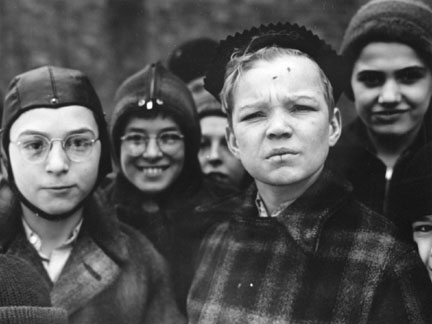
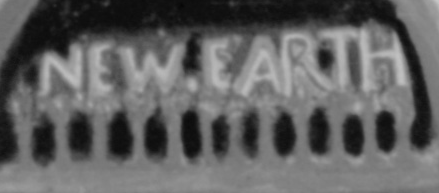
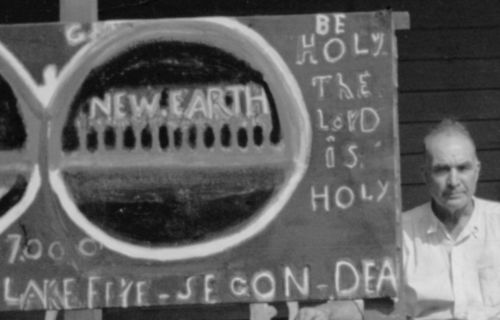
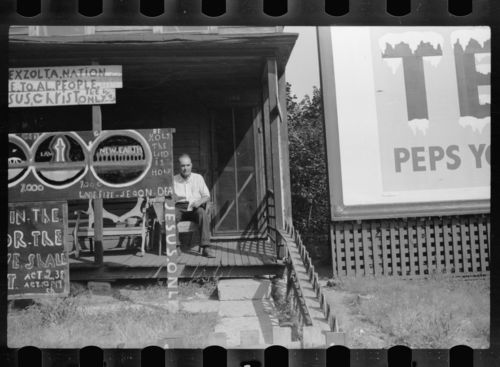


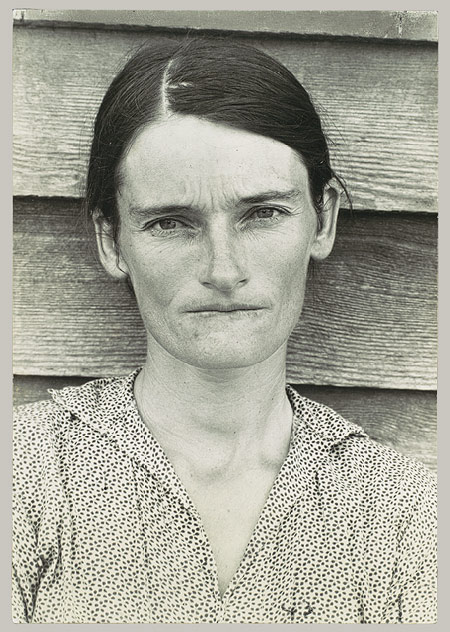
![[Shoeshine stand detail, Southeastern U.S.]](http://lcweb2.loc.gov/service/pnp/fsa/8c52000/8c52400/8c52459r.jpg)


